
- Weill Cornell Medicine


Slips, Trips, and Falls: Understanding, Preventing, and Mitigating Risks
By Gian Joseph, Safety Advisor
As we enter the rainy and cold season, we face several risks , which include slips , trips, and fall s in our day-to-day activities. It is important t o be aware of hazards around us and learn how to properly identify and assess any risks with each step.
Slips, trips, and falls (STFs) are common accidents that can lead to severe injuries. These incidents occur in various settings, from homes and workplaces to public spaces , and i t is essential to understand the causes, consequences, and , most importantly, strategies for prevention and mitigation.
1. Understanding the Dynamics of STFs. STFs are caused by the following .
Insu fficient friction between the shoe and the walking surface. Common causes include wet or greasy floors, spills, and loose debris (Slip and Fall Accidents, 2021).
When a person's foot collides with an object or an uneven surface, it caus es them to lose balance. Typical trip hazards include cluttered walkways, electrical cords, uneven flooring, and damaged or upturned mats (Slip and Fall Accidents, 2021).
2. The Impact of STFs
Slips, trips, and falls have far-reaching effects, affecting individuals and society . Personal i njuries range from minor cuts , bruises, sprains , and abrasions to fractures, dislocations, and head injuries (National Safety Council, 2021). The medical expenses associated with treating STF-related injuries can be substantial , including hospital stays, surgeries, rehabilitation, and ongoing care (National Safety Council, 2021). STFs can result in missed workdays and reduced productivity for both individuals and employers. Workers' compensation claims and absenteeism contribute to economic costs (National Safety Council, 2021). Lastly, t he physical and psychological consequences of STFs can limit mobility, independence, and overall quality of life, especially among older adults ( Sahyoun et al., 2020).
3. Prevention and Mitigation Strategies
Preventing and mitigating STFs involves a combination of awareness, environmental modifications, and education . H ere are some ways you can take precaution s against STFs in your daily activities;
Clear Pathways: Maintain clear, unobstructed walkways by removing clutter and tripping hazards such as cords, toys, and loose rugs (Occupational Safety and Health Administration [OSHA], 2002).
Adequate Lighting: Ensure proper lighting in all areas, both indoors and outdoors, to improve visibility and reduce the risk of tripping over obstacles (OSHA, 2002).
Slip-Resistant Flooring: Install slip-resistant flooring materials, especially in areas prone to moisture, like bathrooms and kitchens (OSHA, 2002).
Footwear: Encourage the use of proper footwear with good traction, especially in environments where slip hazards are prevalent ( Sahyoun et al., 2020).
Handrails and Guardrails: Install and maintain handrails and guardrails on stairs, ramps, and elevated platforms to provide support and prevent falls (OSHA, 2002).
Warning Signs: Use signage to alert individuals to potential hazards, such as wet floors or uneven surfaces (OSHA, 2002).
Education and Training: Promote awareness and provide training to individuals on recognizing and avoiding STF hazards (National Institute for Occupational Safety and Health [NIOSH], 2015).
Workplace Safety: Employers should implement safety protocols and conduct risk assessments in the workplace, addressing potential STF risks (NIOSH, 2015).
Regular Maintenance: Routinely inspect and maintain buildings, walkways, and outdoor areas to identify and address potential hazards promptly (NIOSH, 2015).
4. A Holistic Approach to STF Prevention
Preventing and mitigating STFs require a collaborative approach involving individuals, organizations, and communities:
Individuals : Exercise caution when walking, especially in unfamiliar or potentially hazardous environments. Wear appropriate footwear and take your time, especially in wet or slippery conditions ( Sahyoun et al., 2020).
Employers: Create a safe work environment by identifying and mitigating STF risks. Provide training to employees on safety protocols and the proper use of equipment (OSHA, 2002).
Property Owners and Managers: Ensure properties are well-maintained and free from hazards. Regularly inspect and address issues promptly (NIOSH, 2015).
Government and Local Authorities: Enforce building codes and regulations that promote safety, especially in public spaces and commercial buildings (OSHA, 2002).
Conclusion
Slips, trips, and falls are preventable accidents that carry substantial personal, economic, and societal costs. By comprehending the causes, consequences, and prevention strategies, we can significantly reduce the incidence of STFs and mitigate their impact. Whether at home, at work, or in public spaces, prioritizing safety and fostering awareness about STFs is crucial for the well-being of individuals and communities. Let us strive collectively to create environments where everyone can move safely and confidently, free from the fear of falling.
References:
National Institute for Occupational Safety and Health (NIOSH). (2015). Preventing Slips, Trips, and Falls in Wholesale and Retail Trade Establishments. https://www.cdc.gov/niosh/docs/2015-100/pdfs/2015-100.pdf
National Safety Council. (2021). Injury Facts. https://injuryfacts.nsc.org/work/overview/work-safety-introduction/work-...
Occupational Safety and Health Administration (OSHA). (2002). OSHA Publication 3151-12R. Preventing Slips, Trips, and Falls in Wholesale and Retail Trade Establishments. https://www.osha.gov/Publications/osha3151.pdf
Sahyoun , N. R., Pratt, L. A., & Lentzner , H. (2020). The Changing Profile of Nursing Home Residents: 1985-1997. Journal of Aging and Health, 12(3), 336-363.
Slip and Fall Accidents. (2021). InjuryClaimCoach.com. https://www.injuryclaimcoach.com/slip-and-fall-accidents.html
Please note that the sources cited are accurate as of the time of writing this article. For the most current information, consult authoritative sources and local health authorities.
Go to the staff directory for individual contacts within EHS. You may also use the Weill Cornell Medicine online directory to search for faculty and staff.
Create an EHS Incident
Weill Cornell Medicine Environmental Health and Safety 402 East 67th Street Room LA-0020 New York, NY 10065 Phone: (646) 962-7233 Fax: (646) 962-0288
- +1 (800) 826-0777
- VIRTUAL TOUR
- Mass Notification
- Threat Intelligence
- Employee Safety Monitoring
- Travel Risk Management
- Emergency Preparedness
- Remote Workforce
- Location and Asset Protection
- Business Continuity
- Why AlertMedia
- Who We Serve
- Customer Spotlights
- Resource Library
- Downloads & Guides
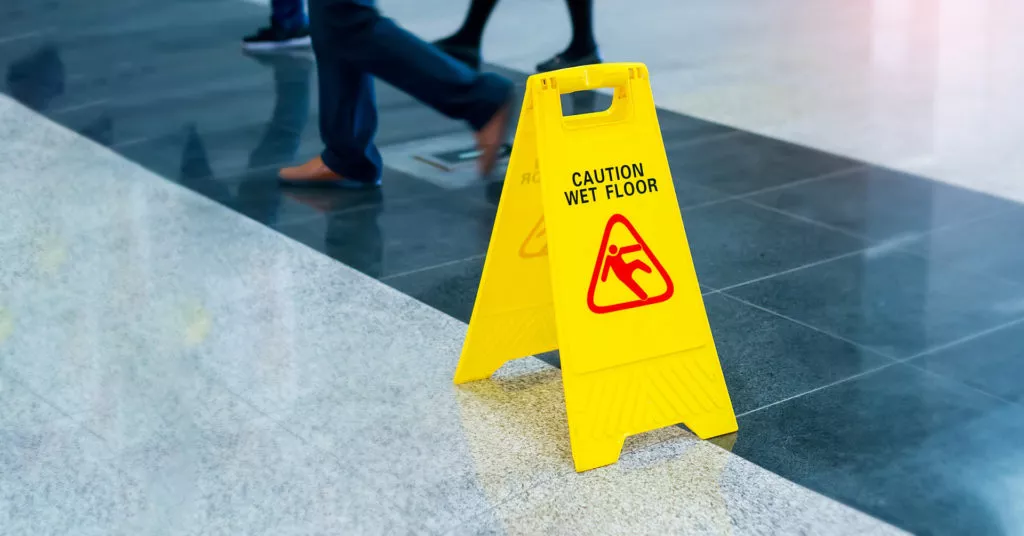
Prevent Workplace Slips, Trips, and Falls—8 Safety Tips
Mopping up a spill or double-checking a guardrail might seem like simple common sense, but slips, trips, and falls are the second most common cause of death at work. These are life-saving procedures. Keep reading for practical tips to prevent workplace accidents.
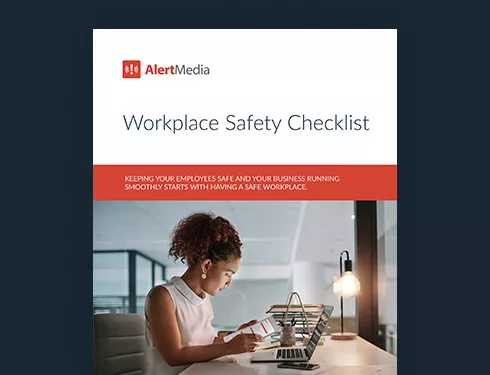
- Slip, Trip, and Fall Hazards Listed
- Clarifying OSHA Standards
- Prevent Workplace Slips, Trips, and Falls
These are familiar scenarios at home: slipping on a wet floor in the kitchen and tripping over a toy left out by the kids. While annoying, these accidents are typically minor hazards in the home. You might stub your toe, but rarely are there severe consequences.
In the workplace, it’s a different and far more serious story. Slips, trips, and falls account for over 200,000 workplace injuries per year. In 2020, nearly one in five accidents leading to missed work was due to a slip, trip, or fall. They’re also the second-leading cause of workplace fatalities.
As a safety leader, you’re responsible for your company’s duty of care and for providing a safe workplace . This blog post will examine common hazards leading to slips, trips, and falls and the steps you can take to minimize injury risks for your team.
Download Our Workplace Safety Checklist
What are slip, trip, and fall hazards in the workplace.
Accidents involving slips, trips, and falls are often grouped together. While they’re similar, it’s important to understand the distinction since they each have different causes and consequences.
Slips occur when someone’s footwear loses traction with the surface they’re on, causing a loss of balance. Under some circumstances, slipping can lead to a fall.
Trips happen when someone hits their foot or lower leg on an object. As their upper body continues moving forward while their lower body remains stationary, the person may lose their balance in the process.
Falls often result from slips or trips, but they can also happen on their own. For example, a worker on a ladder or scaffolding can lose their balance and fall without slipping or tripping. Falls are also possible on flat surfaces and can still cause serious injuries.
Once you understand the hazards that lead to each type of accident, you can identify and mitigate risks in your workplace. Here are some of the most common causes of slips, trips, and falls in the workplace:
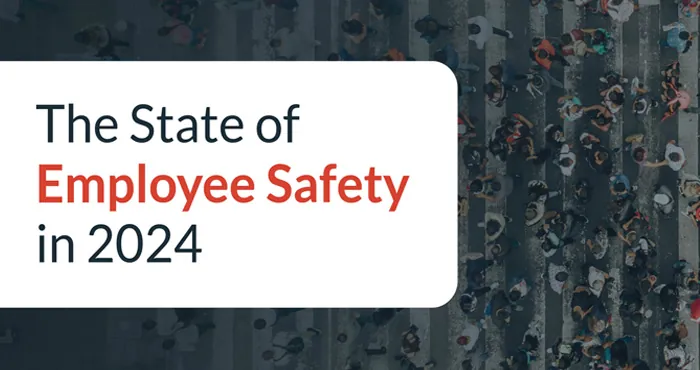
Slip Hazards
- Spills of wet or dry substances
- The cleaning process during spill removal
- Employees rushing or not paying attention to workplace conditions, especially while carrying objects
- Slippery floor surfaces such as marble or laminate
- Wet surfaces
- Poor lighting that obscures hazards
- Inappropriate footwear for the environment
- Transitioning between different types of surfaces
Trip Hazards
- Objects or obstructions in walkways
- Uneven surfaces on flooring or concrete
- Cables, cords, and hoses that aren’t properly secured or organized
- Unmarked steps or ramps
- Irregular stairs or stairs without railings
- Carpet, rugs, or mats with wrinkles or lifted edges
Fall Hazards
- Improperly used or poorly maintained ladders
- Elevated surfaces without guardrails
- Floor and wall openings
- Working in elevated environments without a safety harness
- Ill-fitting or improperly used PPE, such as helmets and safety lines
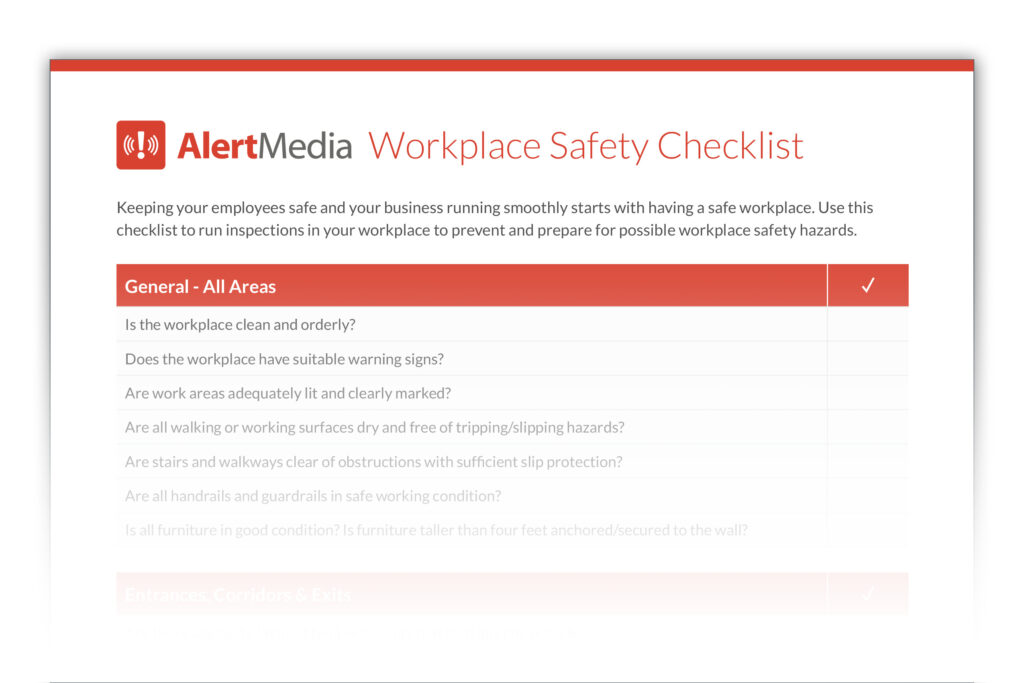
Preview the Workplace Safety Checklist
Are There OSHA Standards Related to Slips, Trips, and Falls?
Despite how common these injuries are, there is no specific OSHA standard on slips, trips, and falls. However, several OSHA rules indirectly address the same hazards.
The most important regulation to be aware of is 29 CFR 1910 Subpart D, which covers walking and working surfaces. OSHA updated the standard in 2017, introducing many upgrades to fall protection system requirements, improved employer-provided inspection guidelines, and a greater emphasis on safety training for employees.
For the construction industry, 29 CFR 1916 contains numerous fall-related regulations. Subpart M specifically addresses fall prevention, but other sections, such as Subpart L (scaffolds) and Subpart E (personal protective and lifesaving equipment), are also relevant. OSHA used 29 CFR 1916 as guidance when revising 29 CFR 1910, so the two guidelines now reflect many of the same OSHA violations .
As with any other workplace hazard or accident, OSHA recordkeeping requirements still apply in the event of a slip, trip, or fall incident. Internally, the reporting process is also an opportunity to review the details of the incident and determine how you can update your workplace safety policy to prevent similar accidents in the future.
How to Prevent Slips, Trips, and Falls in the Workplace
Many hazards that cause slips, trips, and falls are inevitable. However, injuries and accidents are not. To prevent slips, trips, and falls, train your employees to follow a three-step process:
- Recognize the hazard: Identify conditions that could lead to a slip, trip, or fall.
- Evaluate the hazard: Examine the situation and determine what level of risk it presents and who it affects.
- Control the hazard: Avoid the risk by removing the hazard (such as mopping up a spill) or implementing safety equipment and procedures (such as installing handrails on an elevated platform).
Here are eight workplace safety tips to prevent falls, trips, and slips.
1. Teach situational awareness
Since many causes of slips, trips, and falls are foreseeable, situational awareness in the workplace is one of the best preventative measures. Encourage your employees to pay attention to their surroundings and the risks they present:
- Look at walking surfaces for spills, obstacles, or other potential hazards
- Watch for signage that warns of increased hazards
- Be aware of conditions such as weather or time of day that might increase the risk of an accident
- Take shorter and more cautious steps on slippery surfaces
2. Encourage proper footwear
Like any other form of PPE, proper footwear can significantly reduce the risk of accidents. Research has found that slip-resistant shoes can reduce injury claims by 67% in environments with slippery work surfaces.
Employees should regularly inspect their shoes and make sure the soles aren’t worn out, as the lack of tread increases the danger of slipping. Additionally, anyone who works in conditions exposed to winter weather hazards should wear insulated boots. Cold temperatures can decrease muscle function, increasing the risk of slipping, tripping, or falling.
3. Utilize signage
Signage is an effective warning system for many workplace risks, but it can be especially effective in preventing slips, trips, and falls. There are two types of signs you can use to increase occupational safety:
- Temporary: Use warning signs while addressing a new hazard, such as cleaning up a spill, repairing a handrail, or replacing a ripped carpet. While temporary signage can help prevent injuries, you still need to address the actual hazard as quickly as possible.
- Permanent: For unavoidable hazards, such as slippery surfaces, a permanent sign can help warn employees to be careful. Use these sparingly, though, as it’s easy for people to ignore signs they see every day.
4. Keep floors clear and clean
Good housekeeping can help prevent most slips, trips, and falls. The details of keeping walking areas clean will vary widely by work environment, but there are a few common themes to encourage workplace safety:
- Report spills immediately, and warn nearby employees until someone can clean the contaminated surface
- Keep walkways clear of obstacles, loose objects, and anything that someone could trip over
- Place mats at entrances and exits so people can dry their shoes and avoid tracking water or other substances around the workplace
- Install handrails on stairways and elevated walkways
5. Apply non-slip mats and coatings
In some situations, keeping floors from becoming slippery is nearly impossible. Whether it’s liquid splashing or steam condensing, you must focus on mitigating the risk rather than avoiding it altogether.
For smaller or less demanding settings, non-slip mats can help employees maintain traction while walking around. In other cases, treating the floor with a permanent coating can help reduce slipping risks, even in the constant presence of liquids.
Who is at risk for slips, trips, and falls?
While all industries have some level of risk for a slip, trip, or fall, there are some industries where the risk is much higher, and the potential result could be much more dangerous. Here are some of the highest-risk industries:
- Construction
- Manufacturing
- Transportation/shipping/logistics
- Outdoor maintenance/groundskeeping
- Foodservice/hospitality
6. Ensure proper lighting
To identify slip, trip, and fall hazards, your employees need to be able to see their surroundings. Make sure that all of your work areas have proper lighting, especially in areas that are more prone to unsafe conditions.
While this can be a challenge in outdoor work environments, especially at night, it’s even more critical in those situations. Environmental conditions can lead to increased risks, and employees need to be able to see and avoid them. Adequate lighting should also extend to parking lots and walking areas around your facilities.
7. Develop safety programs
Your company’s safety plans and programs should include specific guidelines for preventing slips, trips, and falls. There are a few key topics to consider when developing these policies:
- The types of surfaces employees work and walk on and whether they present extra risks
- Seasonal or regional conditions that could heighten hazards, such as winter weather threats
- Specific OSHA regulations that apply to your workplace
- Potentially hazardous equipment training such as ladder safety
- Regular inspection plans to ensure your team is maintaining a safe work environment
- Policies to report hazards using your company’s two-way communication platform
- First aid training , so employees are prepared to respond safely should injuries occur
8. Provide Slips, Trips, and Falls Training
Lastly, training your employees to avoid slips, trips, and falls will help keep them safe. Provide specific guidance on the environments they’ll work in and the hazards they’ll face. For example, a slips, trips, and falls safety talk for food service workers should focus on wet floors and walking safely in crowded, fast-paced environments. Conversely, office workers could use extra reminders to watch for stray power cords and keep walkways clear of boxes, files, and other tripping hazards.
Working slips, trips, and falls into your safety topics for meetings is also helpful. Regular safety talks or safety moments are an excellent opportunity to remind your team about seasonal risks or update them on newly installed safety measures.
Don’t Let Your Safety Standards Slip
Slips, trips, and falls are some of the most common workplace injuries. Fortunately, you can usually prevent them with proper planning and safety measures.
By making slip, trip, and fall prevention a part of your company’s safety culture, you can ensure your employees are aware of their surroundings and ready to look out for each other’s safety. Enable them to report hazards easily, address risks quickly, and train them to avoid situations that are likely to cause injury.
With the right planning and prevention, even the most intense work environments can be as safe as a walk in the park.
More Articles You May Be Interested In
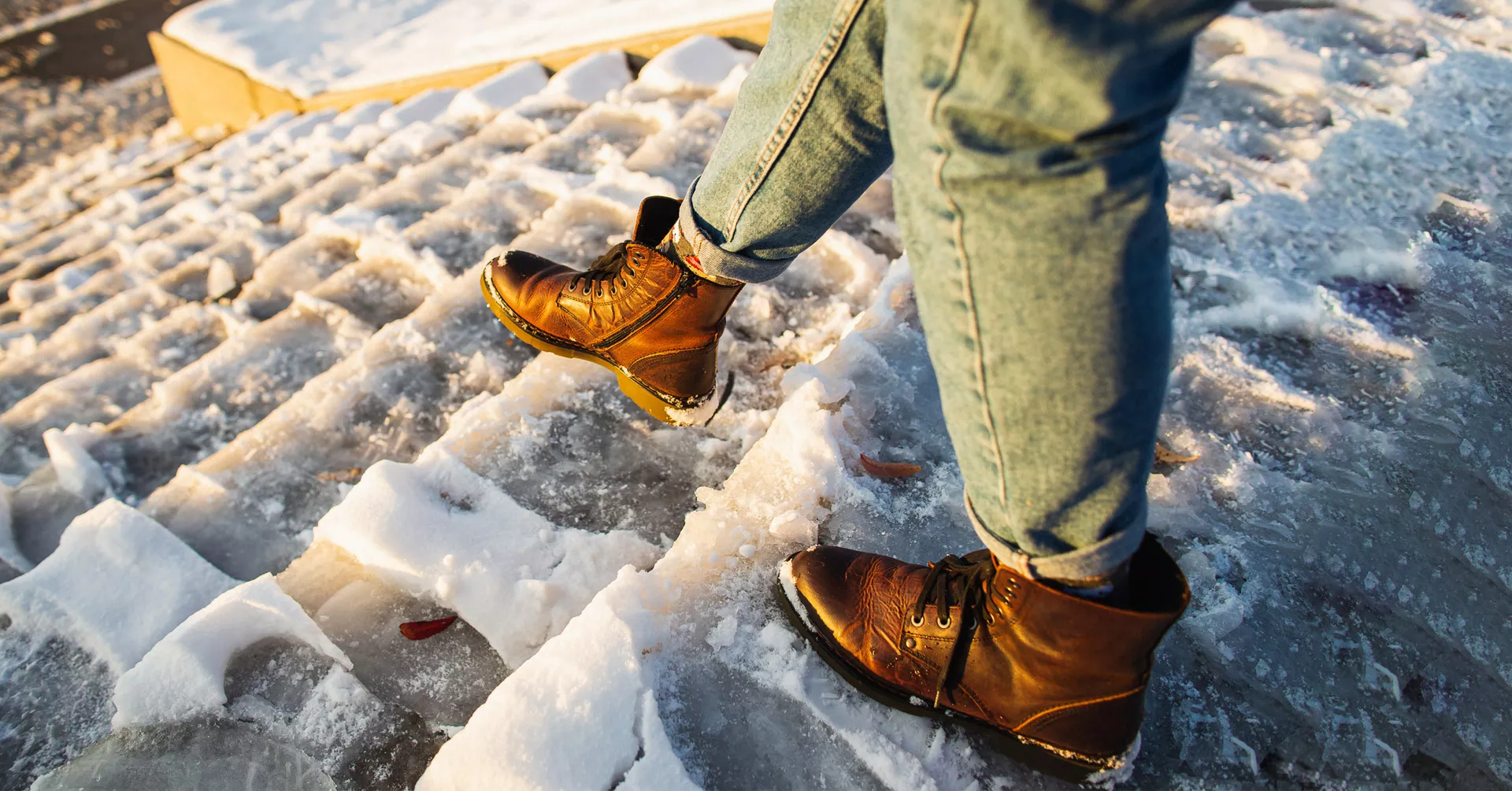
Workplace Safety Checklist
Please complete the form below to receive this resource.
Check Your Inbox!
The document you requested has been sent to your provided email address.
Cookies are required to play this video.
Click the blue shield icon on the bottom left of your screen to edit your cookie preferences.


Slips, Trips, And Falls Hazards | How To Prevent Them
Every year, countless individuals experience the unexpected mishap of a slip, trip, or fall. These incidents occur across all age groups and settings, from homes and public spaces to workplaces. While often brushed off as minor inconveniences or embarrassments, slips, trips, and falls can lead to serious injuries and significant financial and emotional costs.
The key to tackling this pervasive issue lies in understanding the factors contributing to these accidents and implementing effective prevention measures. In this blog, we delve into the causes of slips, trips, and falls, their impact, and, most importantly, how we can prevent them.
By understanding these risks, we empower ourselves to create safer environments, whether looking at the comfort of our homes, the safety of public spaces, or the well-being of employees in a workplace. This guide aims to heighten awareness, encourage preventive action, and highlight our shared responsibility in reducing the risks and consequences of slips, trips, and falls. Join us as we navigate through this important topic step by carefully step.
The Importance of Preventing Slips, Trips, and Falls
The impact of slips, trips, and falls can be highly significant, from bruised shins to broken bones. These incidents aren’t just about physical injury. The repercussions can ripple outwards, affecting an individual’s quality of life, workability, and mental well-being. In the workplace, such accidents can lead to significant downtime, loss of productivity, and even legal implications for businesses. It’s estimated that the annual costs associated with occupational falls run into billions of dollars globally, impacting not just individuals but entire economies. Therefore, it’s clear that these everyday accidents are anything but trivial and that preventing them should be a top priority for everyone.
Basic Understanding of Slips, Trips, and Falls
To prevent these incidents, we first need to understand them. So, what exactly are slips, trips, and falls? A slip occurs when there is too little friction or traction between your footwear and the walking surface, leading to a loss of balance. A trip happens when your foot or lower leg hits an object, and your upper body continues moving, resulting in loss of balance. A fall can result from a slip or trip but can also occur due to other factors, like poor lighting, lack of handrails, or sudden illness.
Each of these incidents can occur under various circumstances. While some common causes include wet or uneven surfaces, poor footwear, and cluttered walkways, there can also be less obvious contributors, like insufficient training or awareness. This article aims to delve deeper into the world of slips, trips, and falls, elucidating their causes, impacts, and, most importantly, the strategies for prevention. The goal is not to instill fear but to inspire a culture of safety, vigilance, and proactive measures to keep everyone safe.
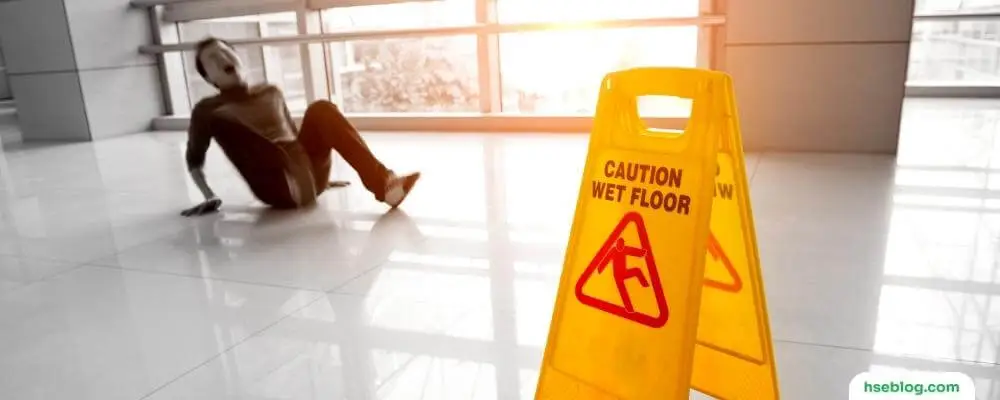
Definition and Differences: Slips, Trips, and Falls
While the terms ‘slips,’ ‘trips,’ and ‘falls’ are often used interchangeably, they refer to distinct occurrences. As we’ve already discussed, a slip occurs when there is insufficient traction between your foot and the walking surface. This lack of grip may cause an imbalance, leading you to fall.
Trips, on the other hand, occur when your foot contacts an object in its path or drops unexpectedly, causing you to lose balance. A trip might occur due to clutter, an obstacle in the pathway, or an uneven walking surface.
Finally, a fall is a sudden, uncontrolled descent for various reasons, including slips, trips, loss of consciousness, or other health-related issues. Falls can occur on the same level (for example, falling on the floor) or from one level to another (like falling down the stairs or from a ladder).
Common Causes of Slips, Trips, and Falls
Understanding the common causes of these incidents is the first step toward prevention. Below are some major factors that often contribute to slips, trips, and falls.
- Wet or Oily Surfaces: One of the most common causes of slips is the presence of wet or oily surfaces. This might occur in areas prone to spills or leaks, such as kitchens, bathrooms, and certain industrial environments.
- Uneven Surfaces, Irregularities, and Obstacles: Uneven walking surfaces or irregularities such as potholes, cracks, or abrupt transitions can cause trips. Obstacles might include clutter, cords, open drawers, and other items that haven’t been stored properly.
- Poor Lighting Conditions: Inadequate lighting can make it difficult to see and avoid potential hazards like spills, obstacles, or changes in level. This can lead to both trips and falls.
- Weather Hazards: Outdoor slips and falls often increase during bad weather conditions such as rain, snow, or ice, which make surfaces slippery and vision less clear.
- Human Factors: Rushing, distraction, fatigue, or lack of proper training can also contribute to slips, trips, and falls. These can often be mitigated through awareness and training.
- Improper Footwear: Footwear unsuitable for the work environment or the current weather conditions can increase the risk of slips, trips, and falls. For example, smooth-soled shoes might not provide enough traction on a wet or oily surface, leading to slips.
- Loose or Unsecured Mats or Rugs: Unsecured mats, rugs, or carpets can shift underfoot or present tripping hazards with their edges.
- Improper Use of Equipment: This might involve using chairs instead of ladders, climbing on shelves, or not using safety equipment correctly, all of which can lead to falls.
- Poor Housekeeping: If work and walkway areas are not kept clean and orderly, they can contribute significantly to slips, trips, and falls. Examples include cluttered workspaces, cables across walkways, or spills not promptly cleaned up.
- Lack of Safety Training: Employees not properly trained on the correct job procedures, including safety equipment, can be at higher risk for accidents.
- Inadequate Maintenance: Neglecting maintenance can lead to hazards such as leaky pipes (leading to wet surfaces), potholes, or uneven flooring, which can cause slips, trips, and falls.
- Poorly Designed Walkways: Walkways with sudden drops, absence of handrails, sharp turns, or inadequate space can increase the risk of falls.
- Medical Conditions: Certain conditions like poor vision, balance disorders, or mobility problems can also increase the risk of slips, trips, and falls.
- Age: Both the very young and the elderly are at an increased risk for falls, partly due to factors such as lack of coordination, decreased strength, or reduced balance.
Remember, while this list of causes is extensive, it is not exhaustive. There may be other contributing factors depending on the specific circumstances or environment. That’s why it’s crucial to carry out regular risk assessments to promptly identify and address potential hazards.
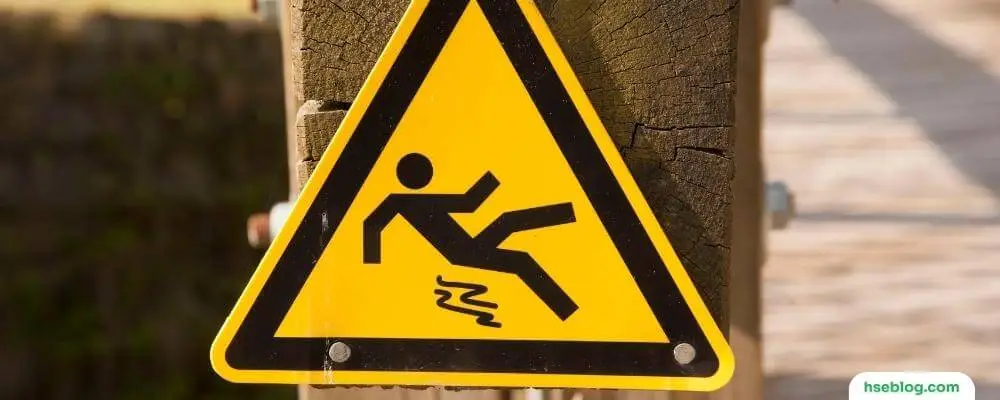
Impact and Consequences Of Slips, Trips, And Falls
The impacts of slips, trips, and falls extend beyond the immediate event and can have lasting effects on the individuals involved and the organizations they belong to. These incidents can result in physical injuries, financial costs, and psychological distress.
Physical Injuries: From Minor to Severe
Physical injuries resulting from slips, trips, and falls can range from minor to severe. Minor injuries may include bruises, abrasions, or sprains. At the same time, more severe cases can lead to fractures, concussions, or even life-threatening injuries such as traumatic brain injuries or spinal cord damage.
In some cases, these incidents can lead to chronic pain or long-term disability, affecting the individual’s ability to perform daily activities or return to work. Falls, in particular, can be especially dangerous for older adults, leading to hip fractures or other serious injuries that significantly impact their independence and quality of life.
Financial Implications: Costs of Accidents
The financial implications of these incidents are also considerable. For individuals, this can include medical expenses, rehabilitation costs, and lost wages during recovery. Additionally, they might face expenses related to modifying their home for accessibility if the fall leads to a long-term disability.
For businesses, the financial costs can be substantial. There are indirect costs besides direct costs like medical expenses and workers’ compensation claims. These can include lost productivity due to employee absence, costs related to training replacement employees, and potential increases in insurance premiums. In severe cases, businesses may also face legal fees if they are negligent in providing a safe environment.
Psychological Implications: Fear and Anxiety After a Fall
The psychological impacts of slips, trips, and falls should not be underestimated. People who have experienced such an incident may develop a fear of falling again. This fear can limit their activities, reduce their independence, and decrease their quality of life.
Anxiety, depression, and social isolation can also result from the fear of falling or the consequences of an injury, such as disability. Employees may experience stress or anxiety about returning to work, especially if they feel the environment is unsafe.
Understanding these impacts highlights the importance of preventive measures to ensure safe environments, reducing the risk of slips, trips, and falls. The following sections will explore strategies to identify potential hazards and implement effective control measures.
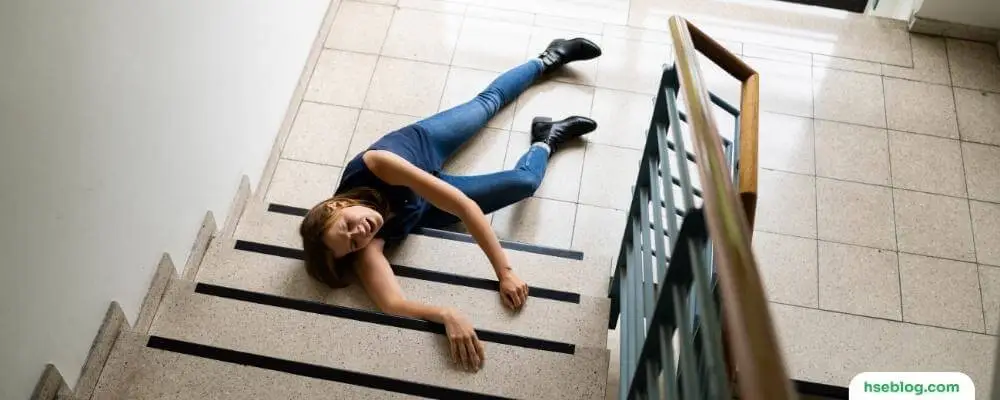
Slips, Trips, And Falls Hazards Risk Assessment
Risk assessment is critical in preventing slips, trips, and falls. It involves identifying potential hazards, evaluating their risks, and determining appropriate control measures. A thorough risk assessment should consider all areas and activities in a given environment, from the home to the workplace.
Identifying High-Risk Areas in the Home or Workplace
High-risk areas vary depending on the setting. These might include staircases, bathrooms, and kitchens in the home, where wet surfaces are common. Outdoor areas like driveways or walkways can also present risks, especially in adverse weather conditions. Any area without sufficient support structures could be risky for older adults or those with mobility issues.
In the workplace, high-risk areas could be those with heavy foot traffic, wet or uneven surfaces, or places with lots of equipment and machinery. Industrial kitchens, construction sites , warehouses, and healthcare facilities are examples of workplace environments that often have high-risk areas.
Key Considerations for Risk Assessment
A comprehensive risk assessment should consider various factors. These include:
- The Environment: Assess the condition of the floors, lighting, staircases, and walkways. Look for hazards like wet surfaces, uneven floors, poor lighting, or lack of handrails.
- Human Factors: Consider the behavior and health of individuals in the environment. Are they rushing? Are they carrying heavy items that may obstruct their view? Do they have any health conditions that increase their risk?
- Tasks: Evaluate the tasks being performed. Does the job involve working at height, handling hazardous substances, or heavy physical labor? Are workers exposed to distractions or time pressure?
- Footwear and Clothing: Assess whether appropriate footwear and clothing are worn for specific environments and tasks.
- Previous Incidents: Look at the history of slips, trips, and falls in the environment. A pattern might indicate a persistent problem that needs addressing.
Importance of Regular Safety Audits
Regular safety audits are essential to maintain a safe environment. These audits involve routinely inspecting the environment and practices to ensure that safety measures are up-to-date and effectively implemented. They help identify new or overlooked hazards and assess the effectiveness of current control measures.
Regular audits also demonstrate a commitment to safety, which can encourage individuals to take responsibility for their safety and that of others. This fosters a proactive safety culture where hazards are promptly reported and addressed, further reducing the risk of slips, trips, and falls.
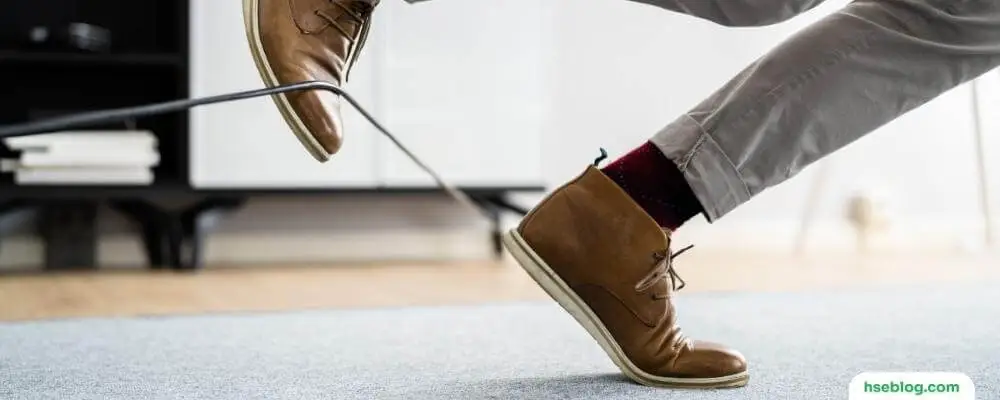
Prevention and Control Measures For Slips, Trips, And Falls
Once potential hazards have been identified through risk assessment, it’s crucial to implement prevention and control measures to mitigate these risks. This involves a range of strategies, from good housekeeping practices to installing safety features.
Housekeeping Best Practices
Proper housekeeping is one of the most effective ways to prevent slips, trips, and falls. Here are some best practices:
- Regular Cleaning: Clean floors regularly and immediately clean up any spills. Ensure to put up “wet floor” signs until the area is dry.
- Declutter: Keep walkways and work areas clear of clutter and obstacles.
- Proper Storage: Store materials and equipment properly when not in use.
- Maintenance: Promptly repair any damages to walkways and work areas, like cracks or uneven surfaces.
Installing Safety Features (Handrails, Non-Slip Mats, etc.)
Installing safety features can greatly reduce the risk of accidents. Here are a few examples:
- Handrails: Install sturdy handrails on all staircases and other areas where individuals may need extra support.
- Non-slip Mats: Use non-slip mats in areas prone to wet or slippery conditions.
- Guard Rails: Install guardrails around elevated platforms, mezzanines, and other fall hazards.
- Visible Markings: Use reflective tape or other visible markings to highlight changes in floor level or other hazards.
Appropriate Footwear for Different Surfaces
Wearing the right footwear can significantly reduce the risk of slips, trips, and falls. Choose shoes with good traction, especially for wet or slippery surfaces. Protective footwear should be worn in workplaces where specific hazards are present, such as construction sites.
Prompt Removal or Correction of Identified Hazards
Address identified hazards as quickly as possible to prevent accidents. If a hazard cannot be immediately removed or corrected, ensure it is clearly marked, and individuals are informed about it until it can be addressed.
Adequate Lighting
Ensure all areas have sufficient lighting to allow individuals to see and avoid potential hazards. This is particularly important for stairways, hallways, and outdoor paths. Replace burnt-out bulbs promptly and consider installing automatic lights in often-used areas.
By implementing these prevention and control measures, you can greatly reduce the risk of slips, trips, and falls, promoting a safer environment for everyone. In the next section, we’ll explore additional strategies and considerations specific to the workplace.
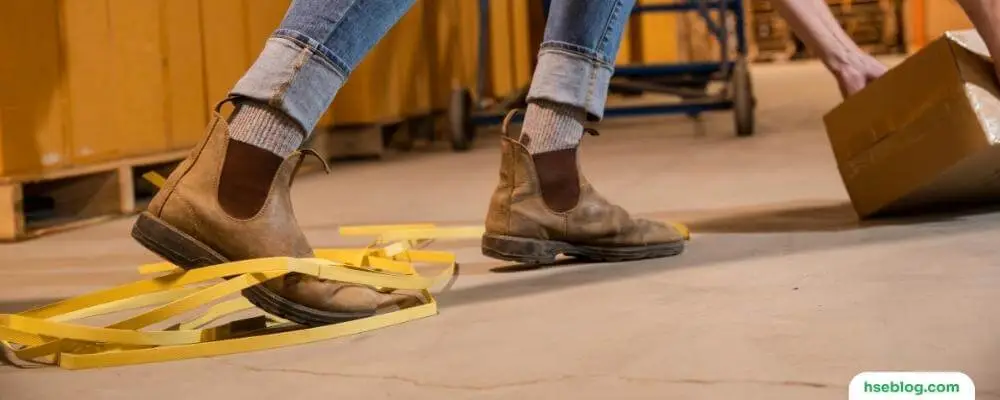
Workplace-Specific Considerations
While many of the principles of slips, trips, and falls prevention apply universally, certain considerations are particularly relevant to workplaces. These involve safety training, employer responsibilities, and industry-specific hazards.
Importance of Safety Training and Awareness Programs
Safety training is vital to workplace safety . Regular training sessions can ensure that employees are aware of potential hazards and the best practices for avoiding them. Training should cover topics such as proper use of equipment, safe handling of materials, and emergency procedures.
Awareness programs, too, can play a crucial role in maintaining a safe work environment. These programs could include regular safety reminders via bulletins, emails, or meetings, encouraging employees to be vigilant and proactive about safety.
Employer Responsibilities and Employee Rights
Employers have a responsibility to provide a safe work environment. This involves conducting regular risk assessments, addressing identified hazards promptly, and providing necessary safety training and equipment. They should also have procedures in place for reporting accidents or hazards and ensure that employees feel comfortable using these procedures without fear of retaliation.
Employees, on the other hand, have the right to a safe workplace and the right to speak up about safety concerns. They also have a role in maintaining safety by following established procedures, using provided safety equipment, and promptly reporting any hazards or incidents.
Industry-Specific Hazards and Control Measures
Every industry has its unique set of hazards, so it’s important to consider these when planning prevention and control measures. For example, spills and hot surfaces might be major hazards in a restaurant kitchen. Measures could include non-slip mats, appropriate footwear, and caution signs. In a construction site, falls from a height might be the primary concern, necessitating guardrails, safety harnesses, and fall arrest systems.
In conclusion, slips, trips, and falls are common but preventable incidents. By understanding their causes and impacts, conducting regular risk assessments, and implementing effective prevention and control measures, we can significantly reduce these accidents, fostering safer homes, workplaces, and communities.
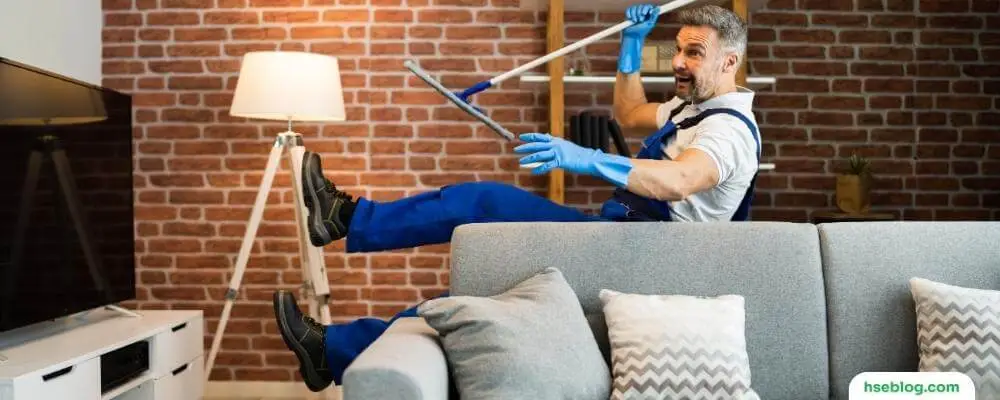
Preventing slips, trips, and falls is no small task, but it is a crucial one. As we’ve explored in this guide, these incidents are far from trivial, carrying the potential for serious physical injuries, significant financial costs, and profound psychological impacts. Yet, armed with the knowledge of what causes these incidents and understanding their impacts, we’re already halfway towards prevention.
The steps to creating safer environments—at home, in public spaces, or at workplaces—aren’t overly complex. They begin with recognizing the potential hazards and involve a thoughtful blend of risk assessment, implementing practical measures, and fostering a culture of safety awareness. From basic housekeeping to installing safety features, each action reduces the risk.
It’s important to remember that the responsibility of preventing slips, trips, and falls doesn’t rest on a single individual or group—it’s a collective effort. Employers, employees, homeowners, and public facility managers all have roles to play. And in our various roles, we all contribute to a larger, shared goal: creating safer environments for everyone.
Preparing for and preventing these incidents can seem daunting in a world where the unexpected is expected. But, as we’ve seen, it’s not only possible; it’s a critical part of our commitment to safety for ourselves and others. Let this guide serve as a reminder and resource for that commitment, helping us make each step we take a safer one. Thank you for joining us on this journey towards safer environments and greater awareness. Let’s continue to take steps, big and small, toward a safer tomorrow.

How to Avoid Slips, Trips, and Falls Caused By Weather

Slips, trips, and falls due to weather
What is the most common cause of slips, trips, and falls , why is it important to prevent slips, trips, and falls in the workplace .
It’s important to prevent slips, trips, and falls in the workplace because a safe working environment not only makes everyone more comfortable, but it also increases productivity . Along with notifying your supervisor of any weather-related hazards, also be sure to lookout for common safety issues. “When we visit a client’s worksite, often we’ll see little pieces of plastic tape on the ground or pieces of paper, those are trip hazards too. The approach should be ‘see something, say something’,” says Morgan.
Who is responsible for creating a safe work environment?
Ultimately, employers are responsible for creating a safe work environment.
“An employer is responsible for ensuring that their facility is free from any recognized hazards. This includes anything that has to do with their facility including power outages, clearing the parking lot and walkways. If trees are down, they are responsible for communicating with the local utility company to have them cleared,” says Morgan.
While workplace safety is an employer responsibility, we all play a role in keeping one another safe at work. “I know that it's sort of sometimes cliche, but we should be each other's keeper. If an employee recognizes a hazard, they should do everything they can to bring it to the attention of the employer,” says Morgan.
How to avoid slips, trips, and falls during winter
The key to avoiding slips, trips, and falls is being aware and proactive. Becoming complacent in your work can lead to accidents. Stay updated on your company's safety procedures and follow the following tips from the Occupational Safety and Health Administration (OSHA) and NSC on how to avoid slips, trips, and falls in the workplace.
- Place wet clothing and outerwear in areas where they dry safely
- Scan you work area for potential hazards before starting work
- If working outside, check the weather forecast — never work in inclement weather
- Wear the proper equipment for the job and tools being used
- Practice safe walking skills, use short, controlled steps
- Call out any hazards to your supervisors immediately
“Employers must empower their workers to use their voice when it comes to recognizing safety hazards. Contract employees should remember that they can also reach out to their Aerotek representatives. We also have a safety hotline where they can share their concerns,” says Morgan. It’s important to remember there are risks associated with all seasons and winter presents unique safety hazards. It’s an employer’s role to provide a safe workplace, but we all can be more proactive in noticing and reporting potential hazards. This helps keep you and your team safe in the workplace. To learn more about Aerotek’s health and safety services, contact us today .
Other Articles

Addressing safety concerns in the workplace can be an intimidating exercise. We have an expert provide a few tips on how to voice your safety concerns in the workplace to management professionally.
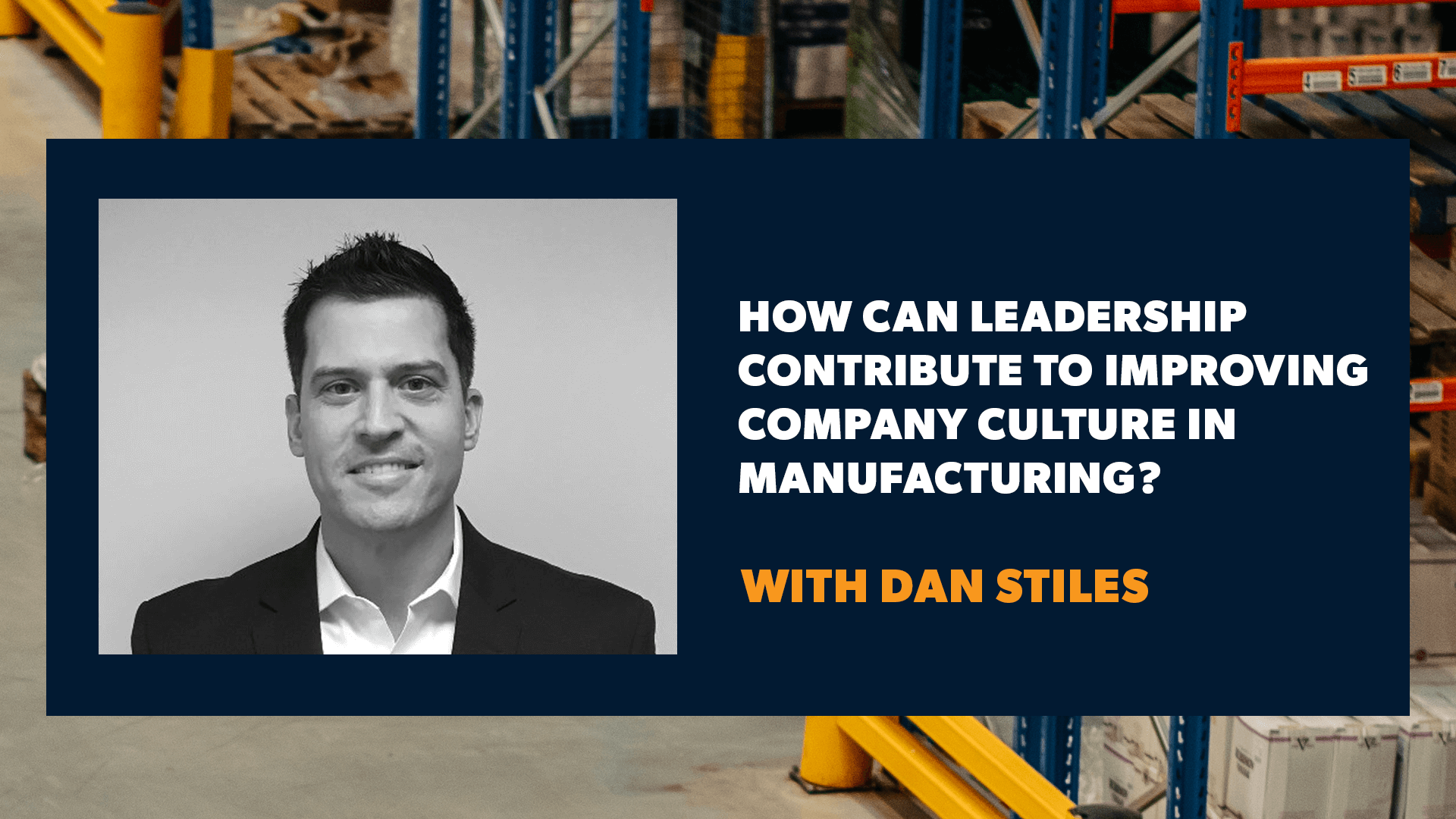
An Aerotek expert explains how auto manufacturers can create a more attractive work culture.

Improved ergonomics can be a benefit to both employers and employees. An Aerotek health and safety expert explains how companies can improve their workplace ergonomics strategy.
1 st Reporting
Slips, Trips, and Falls: A Comprehensive Guide For The Proactive Manager (Part One – Regulatory Requirements)
Posted 11.05.23 by: Jeremy Shantz
Slips, trips, and falls in the workplace are common and the number one cause of workplace injuries. We’re not just talking about minor injuries, either. Believe it or not, something as simple as a carpet in your entranceway can cause severe trauma and, in rare cases, death.
Table of Contents
Understanding Impact
Slips, trips, and falls happen often. In fact, 27.4% of nonfatal workplace injuries in private industry were caused by slips, trips, and falls. If we look at the big data, in 2019 in the United States, there were 888,220 workplace injuries (reported), and 244,000 were slips, trips, and falls caused. ( source )
Statistically, these numbers are quite revealing. The median number of injuries one can expect is 2.8%. So, three of every 100 workers will have an injury at work this year, according to the injury statistics.
This guide will review all the ins and outs of slips, trips, and fall incident management. I’ll provide a roadmap for making management and prevention much easier for you. Stick with me to the end, and I’ll give you my favorite not-so-secret incident management tool advice so you can make your job easier too. Let’s get started.
Understanding Slips, Trips, And Falls
To create a safe and manageable work environment, we must understand exactly what slips, trips, and falls are. You know the common definition, but let’s examine how the authorities view such terms.
Definitions
Most countries in the G20 or UN follow a basic understanding of the incident definition. However, for the purpose of clarity, we’ll use OSHA (Occupational Safety and Health Administration in the United States) for our definitions.
According to OSHA, a slip is when a person loses balance due to a lack of friction between the floor and their footwear. Examples might include wet smooth tile or marble flooring, or if you live in the north, a typical slip scenario is ice on the ground.
Common Causes
- Oil or similar lubricating chemicals
- Wet surfaces
A trip is a scenario where a person loses balance due to a collision between a foot and an object. Practical scenarios might include a fold in a moveable floor rug, uneven flooring or steps, or even objects left on the floor. Trips are potentially dangerous not just due to the collision between foot and object but because they have a tendency to throw a person to the ground. Well, I don’t need to tell you how dangerous that can be when:
- Working at heights
- Working around sharp objects
- Working around moving equipment or vehicles
For obvious reasons, a trip can quickly escalate into a life-or-death severe scenario.
- Uneven flooring
- Objects in walkways
OSHA views a fall as the movement towards a lower level, typically at rapid speed or acceleration (gravity). You might go so far as to assume that the fall is the tail-end of the trip, and in many cases, you would be correct in making that assumption. However, the wording that OSHA uses to define a fall makes the assumption more evident that it intends to regard falling from a higher level to a lower level as the pre-emptive definition of a fall.
Examples of falls include falling off a loading dock edge, falling down some stairs, or falling off your chair (it happens more than you know).
- Unguarded work platforms
- Lack of fall prevention equipment
- Trips and slip events

I’ve provided a few causes of slips, trips, and falls in the workplace, but let’s define the more broad reasons to get the proper perspective.
Environmental Factors
As mentioned earlier, if you’re in North America, Europe, or another place that sees ice and snow in winter, you know that environmental factors can easily cause slips, trips, and falls. Ice, snow, and hail can easily make a person slip and fall.
Rain is also a factor in slipping on smooth surfaces. Naturally, we don’t have many smooth outdoor places where people might slip, but even a wood walkway outside can turn into a slippery surface in the right wet conditions.
Human Factors
Humans are notorious for making problems for each other, and often, it isn’t even intentional. Take a worker who is carrying some boxes and set them down for a moment to answer the phone. Maybe they get distracted and merely forget the box was placed in an aisle. Sure enough, if Murphy is afoot, then someone is going to trip over the box.
Human factors may not be limited to the common practice of leaving a parcel in a walkway. Some jobs require workers to instigate slippery conditions; just think of anyone who has to wash down a truck with soapy water, work with oily equipment, or any number of other common work scenarios that involve processes that could cause slippery conditions. A janitor mopping up a spill is the simplest human factor that comes to mind, especially if there are no slippery when wet floor signs are posted.
Equipment Factors
Although equipment can play a significant role in workplace slips, trips, and falls (in several ways), truth be told, each of the ways that equipment factors into slip, trip, and fall events all go back to a person in some way or another. Here are some of the ways people let
equipment causes dangerous situations that can cause slips, trips, falls, and injury to people.
- Poor Maintenance: Equipment that people improperly maintain can create hazards. For instance, a machine can leak oil or other fluids, creating a slippery surface. Machines or other equipment might also have loose parts that could cause someone to trip.
- Improper Use: Misusing equipment can lead to accidents. For instance, if you use a ladder that’s too short, you might overreach and fall. Don’t stand on chairs or tables in the office instead of using a step stool or ladder. I have found in every job that one person thinks they can stand on a wheeled desk chair to reach something, but I warn you: Don’t do it. You aren’t Spiderman.
- Equipment Placement: The location of equipment can also cause accidents. Electrical cords and cabling are notoriously making people faceplant. If you have ever worked in maintenance (or entertainment), then you’ll know what I’m talking about.
- Inadequate Safety Features: Some equipment may lack necessary safety features that could prevent slips, trips, and falls. For example, a ladder without non-slip feet can easily slide on a smooth surface, leading to a fall.
Similarly, machinery without proper guardrails or other safety devices could put workers at risk of falling. Check your equipment for necessary safety features. Machinery should have proper guardrails or other safety devices to prevent falls. Furthermore, it would be best to insist on daily walk-around safety inspections for all your vehicles or equipment . Enacting smart safety protocols reduces the risk.
- Inappropriate Equipment: Sometimes, the equipment itself is not suited for the job or the environment, increasing the risk of slips, trips, and falls. For instance, forklifts used in an area with a slippery floor can lead to accidents.
- Personal Protective Equipment (PPE): The absence or misuse of PPE can also contribute to slips, trips, and falls. For instance, workers not wearing appropriate footwear for their environment (like non-slip shoes in a wet or oily environment) can easily slip and fall. Similarly, workers who don’t use precautions like a fall protection safety harness are asking for accidents to happen.
To mitigate these risks, ensure that regular maintenance and safety checks of all equipment are standard practice at your workplace. Workers should also have training in correctly using and placing all equipment, and appropriate PPE should be provided and used consistently.
Common injuries

Knowing something and doing nothing about it is pointless. If we look at the data, then we know that each year it is expected that 2.8% of workers will have an at-work accident. That’s 1.4 workers out of 50 (0.7 out of 25). With these numbers, a team of 12 can expect one worker every two years to have an at-work injury. Let’s see what injuries are most common.
Sprains And Strains
Workplace sprain and strain injuries happen most to the torso. In many cases, this means someone’s back. Nearly 40% of injuries in 2021 (In the US) involved the torso.
Not to put too fine a point on it, but the US Bureau of Labor Statistics said back in 2005 that sprains and strains accounted for 43%, and mostly back injuries, of private industry, lost time accidents. That is, 43% of the 1.3 million injuries and illnesses reported in 2003. Twenty years ago, and things haven’t changed much.
According to the injury attorney Adam Skutner (no affiliation), you have a five percent chance of breaking a bone when you slip and fall. I’ve known three people who slipped, fell, and tried to put their hands out to stop the fall. Two of them broke their wrist; the third person sprained it. And that’s just off the top of my memory. So when I hear that five percent break bones, I’m not surprised it’s five percent; I’m surprised it isn’t more.
Dislocations
If you’ve ever dislocated something, then you know it’s as painful as a break. I think of the classic Mel Gibson in Lethal Weapon. He was known for dislocating his shoulder and painfully re-locating it with violent force against a wall or similar structure. However, nothing is entertaining about real-life dislocations, so it’s best to avoid them for obvious reasons.
Contusions And Abrasions
Contusions and abrasions are quite common in workplaces. Even office staff get paper cuts – no one is safe! However, in your business, it’s no laughing matter. A simple paper cut can lead to an infection that can lead to any number of complications. That’s why it’s critical to document everything, even a cut.
At a former job I managed, we had a simple first-aid use form to complete any time a first-aid kit was opened. It was a simple way to document simple injuries like cuts and scrapes that did not require medical attention beyond the first aid kit.
Concussions And Head Injuries
Concussions and head injuries are the most serious concern for anyone in a slip-and-fall event. The healthiest of people can fall the wrong way, hit their head, and end their day (or life).
According to the Washington Post , a study showed that the human skull can withstand 6.5 GPa of pressure. That’s compared to oak (wood) at 11, concrete at 30, aluminum at 69, and steel at 200. Therefore, I wouldn’t put my head in a fight against anything harder than my pillow.
Regulatory Requirements

It’s time to get into regulations. You are responsible for those under your charge as a manager or employer. Let’s see what OSHA has to say about the matter.
Occupational Safety and Health Administration (OSHA) standards
Navigating the landscape of safety protocols and OSHA standards can be overwhelming, but we’re here to break it down for you. The core standards you need to be aware of when it comes to preventing slips, trips, and falls in the workplace are these:
General Requirements (29 CFR 1910 Subpart D): It’s all about ensuring safe walking-working surfaces for your team. Make it a priority to keep these surfaces free from hazards like sharp objects, loose boards, leaks, or spills. Let’s not forget about seasonal hazards like snow and ice too!
Stairways and Ladders (29 CFR 1926.1052 and 1926.1053): These rules are a must-know if you’re in the construction industry. The focus here is on providing safe stairways and ladders to help prevent falls.
Fall Protection (29 CFR 1926.501): Another one for the construction folks out there. This standard mandates that employers provide fall protection systems when workers operate at heights of 6 feet or above a lower level.
Walking-Working Surfaces (29 CFR 1910.22): This one circles back to the general requirements but emphasizes cleanliness and orderliness. You must ensure that all walking and working surfaces are sanitary and well-maintained.
Personal Protective Equipment (29 CFR 1910 Subpart I): Here’s where the right gear comes in. OSHA requires employers to provide employees with appropriate personal protective equipment (PPE) and ensure its proper use. This could include non-slip footwear to help prevent slips and falls.
Remember, it’s not just about ticking boxes and meeting legal requirements. It’s about creating a safe working environment where your team members can perform their duties without fear of slips, trips, and falls.
International Organization for Standardization (ISO) Guidelines
ISO has a specific standard that addresses occupational health and safety: ISO 45001. These standard guides organizations in creating robust health and safety management systems, which inherently involve the prevention of slips, trips, and falls. However, the standard doesn’t go into specific details about these incidents. Instead, it focuses on risk management and hazard identification that would help anticipate and prevent such accidents.
Industry-Specific Regulations
All industries must follow a basic duty standard to provide safe working conditions. However, some industries have specific regulations, which I will review a sample cross-section of below.
Construction Industry
OSHA’s construction safety standards (29 CFR 1926) include detailed requirements for fall protection (29 CFR 1926.501), stairways and ladders (29 CFR 1926.1052 and 1926.1053), and scaffolding (29 CFR 1926.451). These standards mandate using guardrails, safety nets, or personal fall arrest systems when workers are working at heights of 6 feet or above a lower level.

General Industry
OSHA’s walking-working surfaces standards (29 CFR 1910 Subpart D) apply to all general industry workplaces. They require employers to provide safe walking-working surfaces and keep them free from hazards such as sharp or protruding objects, loose boards, corrosion, leaks, spills, snow, and ice.
Healthcare Industry
While there’s no specific OSHA standard for slip, trip, and fall hazards in the healthcare industry, these workplaces must comply with the general industry standards, including the walking-working surfaces standards. OSHA’s guidelines for nursing homes recommend implementing a comprehensive safety and health program that includes an analysis of fall hazards and a plan to control these hazards.
Maritime Industry
For shipyards (29 CFR Part 1915), long shoring (29 CFR Part 1918), and marine terminals (29 CFR Part 1917), OSHA has specific regulations that include requirements for working surfaces, guarding floor and wall openings, and maintaining ladders, stairways, and scaffolds.
Company Policies And Procedures
We have covered what the regulations say, and now it’s time to put that information into action. Creating a health and safety manual is a requirement for most businesses. Although the regulations may vary from state to state or province to province, the concept remains the same: If you operate a business with employees, you should have a health and safety manual.
Along with your health and safety manual, it’s advisable to have job hazard analysis a part of every role within your company or organization. Furthermore, it’s easy to include standards to maintain by providing your team with instructions and procedures to follow within each role. For example, you could include in your housekeeping role manual to utilize wet floor signs and keep pace with any spills to ensure fast clean-up and reduced chances of incidents.
That’s it for part one of our Slips, Trips, and Falls guide for the proactive manager. Check out Part Two for even more about the processes you can implement to take control of slips, trips, and fall incidents at your place of business.

Start reporting today
Join the globally-recognized brands that trust 1st Reporting to safeguard their organizations.
Privacy Overview
Customize your template.
Work with our team of experts to customize our templates to your exact business needs.
- First Name *
- Last Name *
- Phone Number * ✓ Valid number ✕ Invalid number
- Changes Requested
- By submitting your information you agree to receive email marketing and promotional communications from 1st Incident Reporting
- Comments This field is for validation purposes and should be left unchanged.
Free Template Download
- I would like to learn more about a digital solution to manage my reports
- Phone This field is for validation purposes and should be left unchanged.
Slips, Trips, and Falls
Members can click here for an ad-free version of this talk!
Slips, Trips, and Falls Safety Talk
Slips, trips, and falls are one of the leading causes of injuries and fatalities in the workplace. According to OSHA, slip, trip, and fall incidents cause 15% of all accidental deaths and are second only to motor vehicle incidents as a cause of fatalities on the job. These types of incidents can result in life-changing injuries to the employees who suffer them.
Common Slip, Trip, and Fall Incidents
- Falls from elevation are often deadly or result in serious injury and may include falls from ladders, falls off of mobile equipment, falls from roofs or other elevated structures, etc.
- Slip incidents on slippery surfaces such as snow and ice are common in colder geographical areas in the U.S. Wet floor conditions or spilled liquids are also common causes of slip incidents at work.
- Trips can be caused by a multitude of reasons, including poor housekeeping , changes in elevation, poor lighting conditions, improper footwear, etc.
Mitigation Actions to Prevent Slip, Trip, and Fall Incidents
- Always use fall prevention or protection for work over 4ft in general industry work and 6ft in the construction industry. Protect workers by using proper guarding of any holes or open windows and use guardrails to prevent falls. Where guardrails are not feasible, use adequate fall protection. An example of adequate fall protection is a full-body harness and a self-retracting lanyard attached to an approved anchor point with 100% tie-off.
- Proper housekeeping is very important in preventing slip, trip, and falls incidents. Objects on the ground create a hazard for anyone walking or working in the area. Maintain clearly defined paths for walking in the work area. Maintain organized laydown yards for tools and equipment out of the way of employee foot traffic.
- Address any wet, slippery, or icy walking surfaces in your work area. Post signs of any hazardous surfaces until the situation is taken care of completely.
- When climbing up or down a portable or fixed ladder, ensure that you use proper techniques, such as using three points of contact and keeping your belt buckle within the sides of the ladder. Do not lean to reach objects- this can throw off your balance, and you could fall.
Discussion points:
-Are there trip hazards due to improperly placed objects in your work area?
-Has anyone or a close family member of yours experienced a severe fall? How has it affected you/ them?
-What are other ways we can protect ourselves from slips, trips, and falls here at our site?
Slip, Trip, and Fall Safety Presentation
Looking for a complete safety meeting on slips, trips, and falls? This safety meeting focuses on injury statistics, common slips/trips/fall hazards, and best practices to reduce the risk of injuries.
This product bundle includes an editable 10-slide PowerPoint presentation, an editable 7-question quiz, an answer sheet, three related safety talks , and a sign-in sheet.
This product provides everything you need to have a safety meeting and the supporting materials to create a longer safety campaign to keep safety at the top of your employees’ minds.
Save your time by purchasing this slips, trips, and falls safety bundle!

Do you want downloadable PDFs of all of the talks? Join as a member and get all of the 250+ free talks as well as 300+ additional talks in PDFs that are easy to download and print!
One thought on “Slips, Trips, and Falls”
How do i get free safety talks from your site i am needing industrial construction safety talks oil and gas rigging installing piping etc
Comments are closed.
- Our Union Family
- Who We Represent
- Executive Board
- Constituency Groups
- Job Openings
- Report A Problem At Work
- Update Your Membership Information
- Get A Copy of Your Contract
- Find Your Union Representative
- Health & Welfare Benefits
- Know Your Rights
- Free GED Program
- Free Language Classes
- Free Legal Benefit for Giant, Safeway, & Shoppers Members
- Free Workforce Essential Courses
- Scholarships
- Union Deals & Discounts
- Take Action
- Register to Vote
- Join the Active Ballot Club
- Sign Up for Email Updates

Safety First: How to Avoid Slips, Trips and Falls
Jun 14, 2024
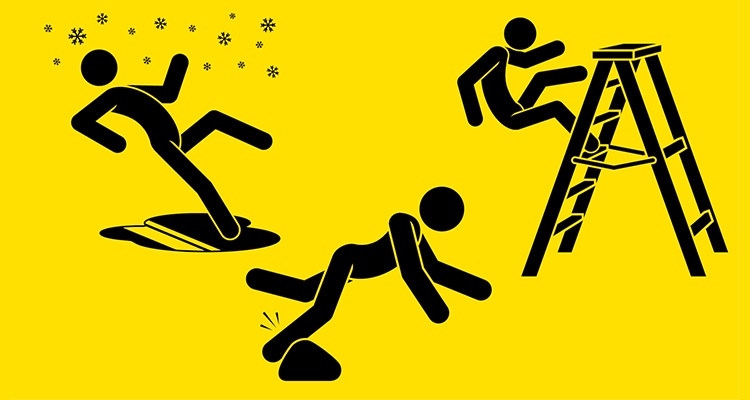
While they may not seem like a leading cause of injury, slips, trips and falls are among the most dangerous hazards we face on the job:
- In 2022, 16 percent of all accidental deaths were the result of slips, trips and falls (Source: Bureau of Labor Statistics )
- A worker died every 96 minutes from a work-related injury in 2022 (Source: Bureau of Labor Statistics )
- Slips and falls are the leading cause of workers’ compensation claims and are the leading cause of occupational injury for people aged 55 years and older. (source: National Floor Safety Institute ).
One reason is that the cause is often commonplace objects that are all around us. All it takes is a misplaced box. A slick floor after customers track in the wet weather. Or a spill from a product on the shelf. Many of us work around these hazards all day long without even noticing, which is why paying extra attention could save you or a fellow coworker from serious injury.
To avoid injury, look out for the following hazards your workplace:
- Walkway surface spills involving oil, water and other liquids.
- Weather-related hazards such as snow, ice and wet surfaces from rain.
- The use of inappropriate footwear.
- Walkway surfaces that are in disrepair.
- Walking surfaces that are too slick or smooth, not allowing adequate footwear traction.
- Clutter around workspaces or in walking paths or aisles.
- Employers failing to train workers about how to avoid slips, trips, and falls.
Your employer is ultimately responsible for maintaining a safe work environment without dangers that can lead to slips, trips and falls. Under the U.S. Occupational Safety and Health Administration (OSHA) Act of 1970 , employers are responsible for providing safe and healthful workplaces for their employees.
Your workplace should take the following preventive measures recommended by OSHA:
- Keep floor surfaces clean and clear.
- Ensure that wet floor signs are posted as needed, and maintain proper drainage.
- Maintain clear aisles and prevent obstructions.
- Ensure that walkway surfaces are in good repair.
- Report and clean up spills immediately.
- Provide non-slip shoes and mats in wet surface areas.
- Minimize carpet and matting trip hazards.
- Use frequent housekeeping procedures and provide adequate lighting in poorly lit areas such as halls and stairways.
- Maintain and eliminate uneven floor surfaces.
In addition, if you have to work outside, OSHA requires employers to ensure that snow and ice are cleared from walking surfaces — and that deicer is spread — as quickly as possible after a winter storm . When walking on snow or ice is unavoidable, your employer is required to train you and your coworkers to wear footwear that has good traction and insulation, and to take short steps and walk at a slower pace.
If you see a safety hazard in your workplace, please contact your shop steward or union representative and inform your supervisor of the safety hazard right away before anyone gets hurt.

Common Triggers of Slips, Trips, and Falls – And How To Avoid Them
Slips, trips, and falls are some of the most common causes of workplace injuries in the US, accounting for over 8 million emergency room treatments every year. While not all these incidents are severe, some will have serious consequences, such as bruises, strains, sprains, fractures, and head injuries.
In many cases, a slip or fall can make it difficult for you to move around, do everyday activities, or live as independently as you used to. It could even force you to take a few days or weeks off work, which will affect your income and productivity.
“Slips, trips, and falls can be frustrating, embarrassing, painful, and costly to you and your family. These accidents often leave victims hospitalized for days or weeks while the utility bills, medical bills, and other expenses collect at your doorstep,” says Alex Bouganim and Joseph Capetola, slip and fall lawyers in NYC .
What To Do If You Slip, Trip, Or Fall
Sometimes, no matter how careful you are, accidents can still happen, and it is crucial that you know what to do in this kind of situation so you can manage it in the best way possible. One of the first steps is to immediately seek medical attention, especially if the fall was quite hard and you are feeling pain anywhere in your body.
Injuries may not always be apparent, and a doctor can help determine specific problems and recommend the proper treatment. Aside from this, a trip to the doctor can help establish credibility if you decide to file a personal injury case or claim compensation against whoever was liable for the accident.
However, if you experience difficulty moving around, do not force yourself to get up right away and look for someone to help you instead. For severe trauma or injury, it is best to call an ambulance and stay in place until they arrive since any sudden movement could aggravate the damage to your body.
Finally, remember to report the incident to the property owner or manager or get someone to do it for you if you cannot move around freely, and make sure that there is proper documentation to help you establish evidence when you claim compensation. It is also a good idea to consult with a legal expert for specific guidance on what to do after a slip and fall accident since the actual steps to do may vary depending on the location and circumstances of the accident.
Common Causes And How To Avoid Them
Awareness is vital in preventing you from becoming a victim of these accidents. When you know the causes of slips, trips, and falls, it becomes easier to avoid them and you can even prevent them from happening to others. Take a look at these common triggers of slips, trips, and falls and what you can do about them:
1. Poor Lighting
Poor lighting can make it difficult to see hazards and other dangers, such as stairs, curbs, or wet and slippery surfaces, increasing your risk of slipping or falling. If you have poor vision, this is even more of a problem because the dim and dark surroundings can hide any obstructions in your path and prevent you from taking evasive action to avoid getting tripped.
To prevent slip and fall accidents due to poor lighting, ensure that all walkways are well-lit, especially in areas with high foot traffic or potential hazards. Install adequate lighting sources, such as overhead lighting or task lighting in darker areas, and immediately replace light bulbs when they burn out.
2. Slippery Or Uneven Surfaces
One of the most common triggers of slips, trips, and falls are slippery or uneven surfaces because they can cause you to lose your footing easily. These are often caused by ice, snow, water, oil or grease, sand, mud or dirt, loose gravels or stones, and man-made causes like waxed floors, which could become slippery due to spills or leaks.
Fortunately, there are many ways you can avoid falling victim to these triggers, and wearing proper footwear is at the top of the list. Shoes with good traction and non-slip soles can help prevent slips and falls, while smooth or worn-out soles can increase your risk. Take extra precautions by immediately cleaning up any spills or wet areas, using non-slip mats in areas prone to getting wet, such as bathrooms or kitchens, and being careful when walking on freshly cleaned or waxed floors.
3. Mats And Rugs
When not correctly displayed or maintained, mats and rugs can result in a slip or trip, especially for an unsuspecting passerby. For example, curled-up edges or lumps in the middle of a rug could entangle your feet and cause you to lose your balance. It is also highly possible for a loose and unsecured rug to slip out of place right when you step on it, leading to a nasty fall and an injury.
To prevent rugs and mats from becoming a tripping hazard, ensure they are properly secured and maintained. Regularly inspect them for signs of wear and tear, and immediately replace any rugs that are frayed, have holes, or are lumped in certain parts. Keep them completely flat, with no bumps or curls on the edges, and use non-slip pads underneath so they stay firmly in place.
4. Excessive Clutter
Aside from being a tripping hazard, clutter can also cause fires, which is why it is essential to do regular housekeeping to prevent these incidents from occurring. Excessive clutter like books, shoes, toys, cords, loose rugs, and stacks of newspapers on the floor create environmental hazards that impede movement and result in blockages that hinder people from walking safely.
You can minimize the occurrence of these incidents by making sure that all walkways, hallways, and stairways are always clear of clutter. Keep your space organized, secure loose cords, and use storage solutions such as shelves, cabinets, or drawers to keep items off the floors and tables.
5. Uneven Or Poorly Built Stairs
Stairs that are damaged or not built according to safety standards can lead to serious injuries, especially if you fall from a higher level. This includes stairways with no handrails covered in dirt and debris or have broken, loose, uneven, or missing steps. Aside from these, obstructions like boxes or clutter on the steps can also cause people to trip and fall.
You can reduce the risk of slipping firstly by ensuring that your stairs are built according to strict guidelines , with the stair slope maximum range being from 30 to 50 degrees. As an additional preventive measure, you can install non-slip surfaces on the stairs, such as rubber or slip-resistant paint, and ensure that stairways are well-lit and have a clear path by removing any items left on the steps like shoes or work equipment that can create potential hazards. Carpeted stairs should also be in good condition with no noticeable deterioration, excessive wear, or missing treads.
The post Common Triggers of Slips, Trips, and Falls – And How To Avoid Them appeared first on What's Trending .

SafeStart solves your biggest challenges - from slips, trips and falls to serious injuries and fatalities - by addressing the human factors common to all of them.
Capabilities.
Discover human factors management solutions that effectively address human error, conquer common injury challenges and improve safety engagement.
- Rate Your State
Organization
- Safety Assessment & Diagnostics
- Human Factors Review
Our safety resources give you the knowledge and stories you need to manage human factors—and won’t find anywhere else.
Safety Resources
Customer success.
- Case Studies
- Video Testimonials
Let us show you how to connect the dots between human error reduction and fewer incidents, better engagement and stronger support for safety.
Workshops & Events
- Event Calendar & Map
Please select your region
Por favor elige tu región Veuillez choisir votre région Per favore scegli la tua regione Por favor escolha a sua região Bitte wählen Sie Ihre Region aus
USA & Canada
- USA & Canada (English)
- Canada (Français)
Latin America
- America latina (Español)
- Brasil (Português)
- International (English)
- France (Français)
- Deutschland (Deutsch)
- Italia (Italiano)
- España (Español)
- UK (English)
- Asia (English)
Slips Trips and Falls
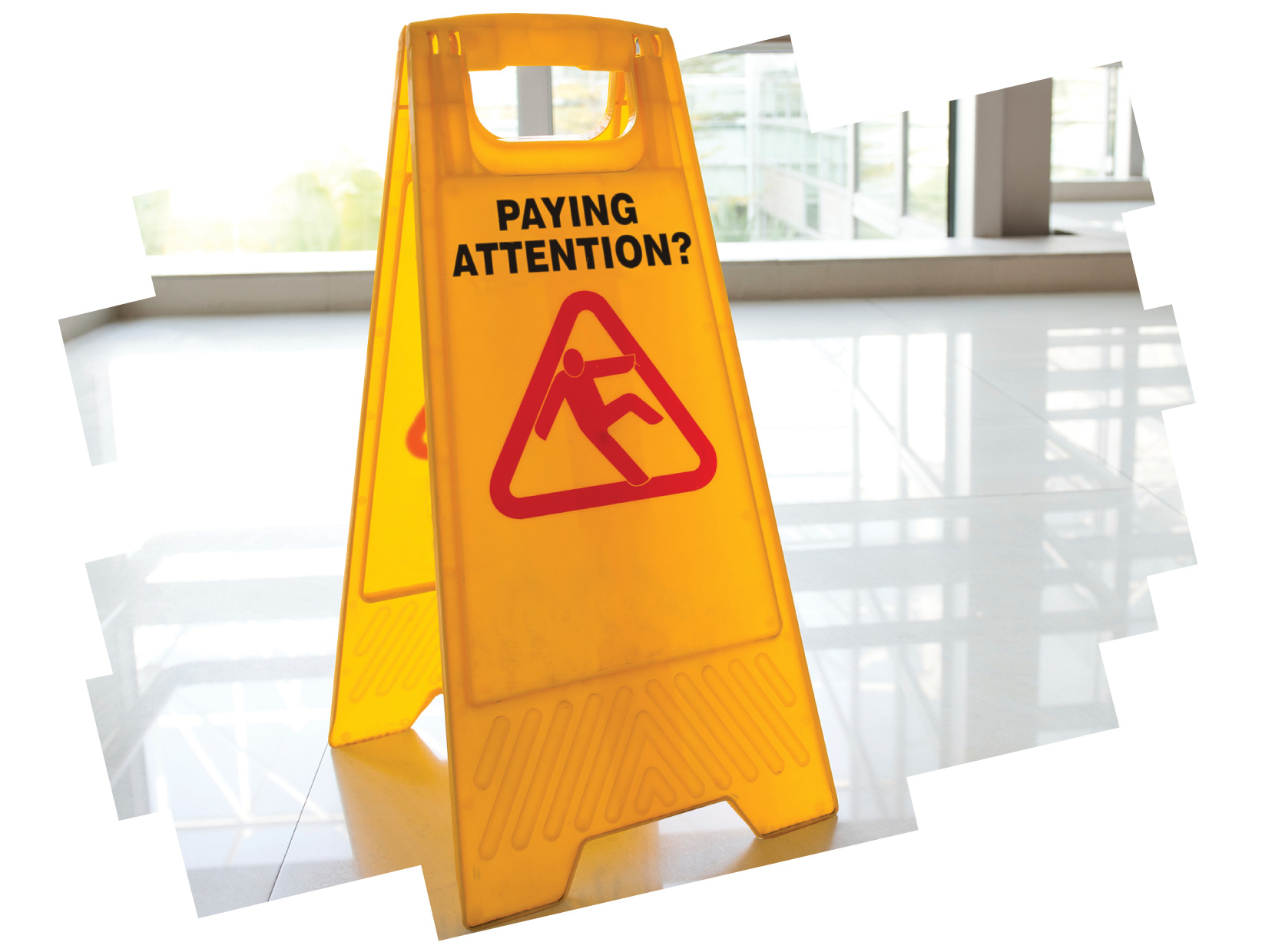
Free webinar
Slips, Trips and Falls
Slips, Trips and Falls: Balancing Human and Physical Causes
Many companies have taken steps to tackle the major physical causes of slips, trips and falls in the workplace, but human factors persist as the biggest cause of these incidents and often remain unaddressed.
Solving Slips, Trips and Falls Once and For All
This guide outlines what you can do to reduce slip, trip and fall injuries by addressing both physical causes and human factors.
Human Factors in Slips, Trips and Falls
Incorporate these slides into your existing slip, trip and fall training.
The 12 Toolbox Talks of Holiday Safety
November 23, 2022
The holidays are a busy time for everyone. There’s something to be said about the right decorations to set the tone for the season. But unfortunately for some, the holidays are also a time when injuries and fatalities increase—and it could be because people are so focused on the season that they fail to see…
Use SafeStart Teachings for a Safe Halloween
October 25, 2022
At Halloween, children can have a hard time staying focused on anything but racing to the next house for candy. This year, why not try a little SafeStart talk to get them thinking about safety? A quick reminder of these common Halloween human factors and other safety tips can help keep them safe as they…
A New Take on Slips, Trips and Falls
January 21, 2021
Regardless of profession or industry, slips, trips and falls are a problem that everyone is familiar with. The reason we are all well versed on the outcome of slips, trips and falls is that they’re a persistent problem among most companies. But sometimes slips, trips and falls aren’t taken as seriously as they should be.…
4 Winter and Holiday Safety Toolbox Talk Topics for December
November 24, 2020
The month of December brings a lot of things, most notably the holidays—there’s Christmas, Hanukkah, New Year’s Eve and a number of parties to mark the occasions. But December also brings a long list of recurring incidents and injuries year after year. The good news is you can protect your workers by delivering some well-prepared…
4 Unspoken Hazards of Waste Collection
July 2, 2019
Every day, waste collectors face a number of hazards that range from vermin to chemical poisoning. In fact, refuse and recyclable materials collection is one of the most dangerous jobs in the U.S. and most employees in this industry are likely to get injured at some point in their working lives. One of the most…
4 Common Safety Issues in the Aviation Industry
December 18, 2018
Among the many workplace hazards that affect aviation workers, falls and back injuries are the most common. The industry shares a lot of similarities with other sectors where people frequently trip and fall or hurt their backs despite engineering precautions and training on correct lifting techniques. When rushing or complacent, people are likely to ignore…
Solved: The Most Effective Way to Overcome Slips, Trips and Falls
August 30, 2018
Despite various engineering solutions used by safety managers, the number of slips, trips and falls incidents in the workplace refuses to go down. In fact, the issue remains one of the top problems for safety professionals. This subject was addressed by Ray Prest in the Winter/Spring 2018 issue of the Safety Decisions Magazine. In his…
How to Finally Get Traction on Slips and Falls in Oil and Gas
June 21, 2018
Work conditions in the oil and gas industry are often hazardous and every year many workers are hurt or killed while performing their job. And although there are numerous dangers facing oil and gas workers on a daily basis—from chemical exposure to explosions and fires—a significant number of injuries and deaths is caused by slips,…
How to Prevent Top 5 Construction Risks
April 17, 2018
Construction site safety is a concern for all those who supervise and manage the projects. Thousands of workers are injured or killed on job-sites each year, and many of those incidents are entirely avoidable. Understandably, supervisors and managers are required to maintain a safe and healthy workplace. Managing construction safety risks requires recognizing the most…
Here’s Why Safety Pros Don’t Stop More Slips, Trips and Falls from Happening at Work
January 12, 2017
Slips, trips and falls are a major safety concern in almost every industry. Based on data gathered by the National Safety Council: Falls are the third-most common cause of off-the-job deaths among workers. Slips, trips and falls account for 26% of all injury-related visits to the emergency department for people ages 25 and up. In…
3 Big Causes of Slips, Trips and Falls
May 16, 2016
This is an excerpt from our free guide on preventing slips, trips and falls. A 2014 survey of 1,294 safety professionals revealed the most frequent factors in slip, trip and fall incidents at their workplaces—and a whopping 95% of respondents cited one of three causes. The main characteristic the three biggest causes have in common…
Why You’re Still Struggling with Slip, Trip and Fall Incidents
August 31, 2015
Slips, trips and falls are a common problem in the workplace. In fact, they’re the second-leading cause of workplace injury according to the NSC Injury Facts – and they have been for quite a while. Even though most safety programs outline clear measures to prevent these types of incidents, workers still end up getting injured…
Slips, Trips and Falling into the Deep End
June 29, 2015
School’s out for summer… and that means many of us will be spending more time supervising kids while they swim. What’s more exciting than getting into the pool? Most kids, against their parent’s continual warnings, love running into and around the pool and never think about the associated risk. Decks become very slippery from the…
Free Webinar on Slips, Trips and Falls
June 22, 2015
It’s a constant balancing act to deal with slips, trips and falls in the workplace. You need to stay on top of compliance measures like housekeeping and maintenance. But the biggest cause of slips, trips and falls is worker distraction—and that requires an entirely different set of solutions. There is an exciting free webinar on how…
The Surprising Cause of Most Slips, Trips and Falls
May 5, 2015
Slips, trips and falls are a major challenge for safety professionals. Not only are they responsible for 25% of all occupational injuries that require time off work, but they’re also notoriously difficult to solve. So how do you reduce the number of slips, trips and falls in the workplace? To answer that question, you need…
Free Guide to Solving Slips, Trips and Falls
February 25, 2015
Slips, trips and falls are a problem in workplaces in almost every industry. A recent survey of safety professionals revealed the biggest three causes of slips trips and falls—and the results should make safety folks sit up and take notice. It turns out that the majority of slips, trips and falls involve human factors. Whether…
Infographic on Slips, Trips and Falls
February 10, 2015
A new report from BLR Safety Daily Advisor shows how safety professionals view the problem of slips, trips and falls in the workplace. The report was produced after surveying over 1,200 safety professionals about the impact of slips, trips and falls on their workforce and which solutions they’ve implemented to deal with the issue. The…
Get up-to-date UND safety information.
Recognizing and preventing work-related injuries in colleges
In 2021 there were 132 work-related fatalities in education, according to the National Safety Council. Although this does not seem like much, educators often consider a college campus a safe place of learning and growth.
However, it is important to remember that higher education institutions are also workplaces. Just like any other workplace, accidents can happen on college campuses. Figures show 95,000 cases of stress, depression, and anxiety in education staff each year.
Understanding work-related injuries
Work-related injuries in higher education can occur in various settings, from classrooms and labs to administrative offices and maintenance areas. These injuries can result from a wide range of activities, including:
- Administrative tasks
- Maintenance work
- Assisting other teachers or staff
Common work-related injuries in higher education include slips, trips, falls, strains and exposure to hazardous materials.
Preventing Work-Related Injuries
Staff and students need to keep the campus environment safe. This includes promptly reporting any hazards, such as loose tiles, wet floors or malfunctioning equipment.
If your work involves sitting at a desk or computer for extended periods, ensure your workspace is ergonomically sound .
Institutions should provide proper safety training to staff who may risk exposure to hazardous materials. Knowing how to use safety gear and handle chemicals can prevent accidents.
Wear appropriate footwear for the tasks you will be performing. Non-slip shoes can help prevent falls, especially during wet or snowy weather.
Familiarize yourself with emergency procedures and the location of fire exits and first-aid kits.
Reporting and seeking help
If you witness or experience a work-related injury on campus, report it immediately to the appropriate authorities. Prompt reporting ensures that staff takes action to prevent further incidents.
By following safety guidelines, maintaining a vigilant attitude and staying informed, staff and students can contribute to a safer campus environment.
Steps to take immediately after the injury
Report the injury: Ensure you report your the injury as soon as possible.
Seek medical attention: Get the necessary medical treatment. North Dakota Workforce Safety & Insurance requires using a designated medical provider.
Document everything: Keep detailed records of the injury, treatment, communications and any expenses related to the injury.
Understanding the workers’ compensation process
Workers’ compensation provides benefits to employees who suffer injuries or illnesses at work. This system can cover medical expenses, lost wages, and rehabilitation costs.
Familiarize yourself with the basics of this process. Understanding deadlines for reporting injuries, filing claims, and the types of benefits available will help guide you through each step.
Support after a workplace injury
When one gets injured on the job, it can be a stressful and challenging time. Knowing how to ask for and receive support through the workers’ compensation process can make a significant difference in your recovery and well-being.
Stay safe out there, take care of yourself and reach out for help it could change your life.
Leave a Comment Cancel reply
Your email address will not be published. All comments will be reviewed prior to posting.
Related Posts
June is National Safety Month – Week 3
June is national safety month – week 2, june is national safety month – week 1.
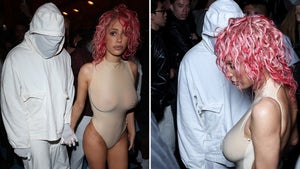
Bianca Censori Bounces Around in See-Through Outfit at Paris Fashion Week

Guess The Celeb Taking A Sexy Summer Shower!

Jennifer Lopez Surfaces in Italy Solo Amid Ben Affleck Marriage Trouble

Bebe Rexha vs. Porsha Williams Who'd You Rather?! (One-Piece Wonders Edition)
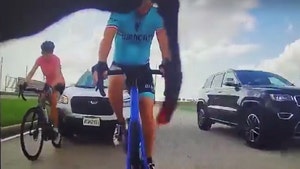
Cyclists Run Over By Hit-and-Run Driver In Graphic Video
Carrie underwood falls off stage on tail end of south carolina concert, carrie underwood falls off stage at s.c. concert ... after rain-filled finale.
Carrie Underwood capped off her concert this weekend by belting out tunes in the rain -- but there was an even more dramatic finish as she was exiting the stage ... 'cause she fell.
The singer was the headlining performance Sunday night at the Carolina Country Music Fest in Myrtle Beach -- where she put on one helluva show that ended up getting highlighted by the fact there was a downpour that seemed to come out of nowhere toward the end.
As much of a spectacle as that was ... there was something else that caught fans' attention as Carrie was making her way offstage -- and that would be her going down, seemingly hard. Even crazier is the fact that it was caught on video ... and we got a hold of the footage.
Check it out ... it's a bit of a subtle moment, but if you look closely, you'll see Carrie take a bit of a tumble -- or at the very least, an awkward stumble -- as she starts to descend some stairs toward the back end of the stage.
Waiting for your permission to load the Instagram Media.
In a flash, it almost looks like Carrie drops through a hole back there ... either way, her disappearance off the stage doesn't look all that natural -- and something clearly went wrong.
You can even hear people in the crowd scream out that she fell ... so folks certainly noticed.
Now, it appears Carrie addressed the fall -- she posted some photos from her gig this weekend ... and touched on something going awry at the end ... although it's a little cryptic.
She writes, "Well, last night sure was fun! And though the ending was quite unexpected, it made for a night we’ll never forget!" CU attached some emojis touching on rain and weather -- but it's possible she might be quietly referring to the fall at the end.
Either way, she seems to be okay -- which is all that matters. We've reached out to her rep for clarification ... so far, no word back.
- Share on Facebook
related articles

Carrie Underwood, Jessica Simpson Topping Book Sales During Pandemic
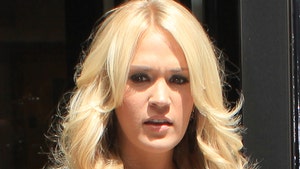
Carrie Underwood Accused Of Ripping Off 'Sunday Night Football' Song
Old news is old news be first.
Election latest: More polls forecast huge Tory losses - with one projecting just 53 seats
Labour are on course for their best-ever election result and the Tories their worst since before the First World War, according to a new YouGov poll for Sky News. It also shows several cabinet casualties, a win for Nigel Farage, and huge gains for the Liberal Democrats across the UK.
Wednesday 19 June 2024 23:03, UK
- General Election 2024
Please use Chrome browser for a more accessible video player
New YouGov poll for Sky News
- Catch up on the day's politics news with our 10pm bulletin
- Labour on course for best-ever election result
- 'Real collapse' in Tory support after 'uplift' for Reform
- Top Tories tipped to lose - with more than half of cabinet at risk
- Look up the projected result where you live
- Sam Coates: Tory wipeout on the cards in multiple regions
- Sky News Daily: What could change before election day?
Other election news
- PM welcomes fall in inflation
- More polls project huge Tory losses
- Police officer in Sunak's close protection team arrested
- Lib Dem leader opens up about caring for late mother and teen son
- Latest manifestos: Sinn Fein | SNP | Workers Party
Election essentials
- Manifesto pledges: Conservatives | Greens | Labour | Lib Dems | Plaid Cymru | Reform | SNP
- Trackers: Who's leading polls? | Is PM keeping promises?
- Campaign Heritage: Memorable moments from elections gone by
- Follow Sky's politics podcasts: Electoral Dysfunction | Politics At Jack And Sam's
- Read more: Who is standing down? | Key seats to watch | What counts as voter ID? | Check if your constituency is changing | Guide to election lingo | Sky's election night plans
It's 10pm and here's your rundown of the day.
It's been a day of manifesto launches and another YouGov poll for Sky News has projected Labour is on course for its best-ever election result - and the Tories set for their worst since 1906.
Here are the main things you need to know:
- The poll projects Labour will win a historic majority of 200 with 425 seats, more than double the 202 won in 2019;
- While the Tories would slump to their lowest number of parliamentary seats since the party's formation with 108, down from the 365 won in 2019;
- Some 15 out of 28 Tory cabinet members still standing in the election are projected to lose , including Chancellor Jeremy Hunt, Defence Secretary Grant Shapps, and Commons leader Penny Mordaunt.
- The Liberal Democrats would win 67 seats under the projection, the SNP 20, Plaid Cymru four and the Greens two;
- Nigel Farage's Reform UK is on course to win five seats, with the party leader becoming an MP for the first time after winning Clacton;
- History teaches us polls tend to narrow during election campaigns, but Patrick English, director of political analytics at YouGov, says "we're just not seeing that at the moment" .
- A police officer in Rishi Sunak's close protection team has been arrested and suspended over alleged bets about the timing of the general election.
- We had an in-depth interview with Lib Dem leader Sir Ed Davey , who discussed topics taking in migration, Brexit and social care, and his experience looking after his son;
- The SNP's economy spokesperson also told Sophy Ridge the party is "fighting for every vote" in response to the YouGov projection showing the party would lose half of its seats;
- The SNP launched its manifesto with a promise to continue its quest for another independence referendum, which the party claims could pave the way for Scotland to rejoin the EU;
- Sinn Fein launched its manifesto, as did George Galloway's Workers Party of Britain .
- Inflation falling back to the Bank of England's 2% target for the first time in three years has been welcomed by Rishi Sunak , but Sir Keir Starmer said people's lives wouldn't "suddenly get easier;
- The prime minister and Labour leader condemned Just Stop Oil members spraying Stonehenge with orange paint;
- Sir Keir's wife also said a protest outside their house - which involved a banner saying "Starmer stop the killing" in reference to the war in Gaza - made her feel "a bit sick".
On today's Sky News Daily podcast, Niall Paterson analyses the implications of today’s poll with our deputy political editor Sam Coates , while Sky’s political correspondent Tamara Cohen joins us from Edinburgh where she was at the launch of the SNP manifesto.
Thank you for following our coverage of the day's political events.
See our 10pm bulletin for the key points from today.
Join us again tomorrow from 7am for the latest updates.
Earlier, YouGov pollsters asked 2,238 people how they felt about various party leaders - and who would make the prime minister.
In a series of head to heads, Sir Keir Starmer came ahead of all the other leaders.
He beat Rishi Sunak by 41 points to 21 points, Nigel Farage by 50 points to 25, and Sir Ed Davey by 40 points to 14.
The rest of the 100% in each case was made up by "don't knows".
Out of the other match-ups, Mr Farage came second in them all - and Mr Sunak lost out to Sir Ed.
The grim news for the Tories in the latest Sky News/YouGov poll begs another question about Rishi Sunak's political judgement. Was a long election campaign a blunder?
The prime minister is already under fire from Conservative MPs and activists for gambling on an election in July rather than waiting for October or November.
The conventional wisdom was that economic news would be better by the autumn and deportation flights to Rwanda would help stop the boats bringing migrants across the Channel.
But as well as doubts about a July poll, the big slump in Tory support since the last Sky News/YouGov poll on 3 June, suggests a long campaign of six weeks may also have backfired.
On 22 May, the day the prime minister made his shock general election announcement, some veteran Tory MPs privately questioned Mr Sunak's decision to fight a long campaign.
But with the Tories trailing badly behind Labour in the polls for months, Mr Sunak clearly hoped a long election campaign would give his party more time to recover and close the gap.
However, the opposite appears to have happened. As the campaign continues, with polling day still two weeks away, opinion polls are suggesting bigger Conservative losses, not smaller.
Read the full analysis here ...
Our live poll tracker collates the results of opinion surveys carried out by all the main polling organisations - and allows you to see how the political parties are performing in the run-up to the general election.
Read more about the tracker here .
By Tamara Cohen , political correspondent
John Swinney has now been on the campaign trail for most of his short time as Scotland's first minister, which began just six weeks ago.
After a turbulent 15 months for the SNP following the resignation of Nicola Sturgeon and then Humza Yousaf, the party of independence is fighting for its life against a resurgent Labour poised to win back some old heartlands.
For the nationalists, this is existential. Having won 48 seats in the 2019 election, they could - according to today's YouGov poll- end up with just 20 seats.
With many seats too close to call, especially in the tightly-contested central belt, other polls have put the SNP far lower, and that leaves its central goal of independence at serious risk.
Read more below:
As well as our mammoth YouGov poll projecting 425 seats for Labour and 108 for the Conservatives, two other polls have been released today showing Labour maintaining its comfortable lead.
A poll by More In Common projected a Labour majority of 162, just shy of its 1997 and 2001 landslides, with the Conservatives falling just 155 seats, their worst total since 1906.
High profile losses forecast in the projection include Chancellor Jeremy Hunt and Defence Secretary Grant Shapps.
But the results were the most favourable for the Conservatives of the recent large-scale polls.
Meanwhile a poll by Savanta projects a drastic result for the Conservatives, with Labour winning 516 seats and the Tories falling to 53 MPs.
It puts Labour 19 percentage points ahead of the Tories, with Labour on 40%, the Tories 21%, Reform 14%, Lib Dems 11%, Green 4%, SNP 3% and other parties 5%.
The More In Common survey forecasts Reform UK winning no seats, with the Tories holding Clacton against Nigel Farage, but the poll is based on data collected between 22 May and 17 June and so includes the period before Mr Farage announced his decision to stand in the seat.
Sinn Fein were one of the parties to launch their manifesto today - but they don't actually sit in parliament.
Why is that? And what role do they have in the general election?
Our senior Ireland correspondent David Blevins explains:
Our deputy political editor Sam Coates praises Sir Ed Davey for his unique way of getting the Liberal Democrats' policies across.
He says he is able to "knit together a policy programme... that people understand why he cares about it, because he links it back to both his son and his mother who he cared for when he was a teenager".
Sam adds: "I think that relatability, along with the stunts everyone has seen, has been the core of his campaign, and it has caught the imagination by being something different."
He says he wondered what role the Lib Dems would play if there was a huge Labour supermajority, "because they don't feel like they are going to go on the attack, they don't feel like they're going to be particularly pugnacious".
"They're an anti-Tory outfit under this guy, Ed Davey. So what really is their role going to be from 5 July onwards?"
That concludes our coverage of tonight's Politics Hub With Sophy Ridge - it'll return tomorrow from 7pm. In the meantime, stick with us here for the latest general election news and analysis.
Ending on a lighter note, Sophy asks Sir Ed which politician he would most like to push off a paddleboard.
"There's just too many they won't fit on," Sir Ed says.
The Liberal Democrat leader has pulled several attention-grabbing stunts during the campaign, including repeatedly tumbling off a paddle board into Lake Windermere… as well as screaming on a rollercoaster, splashing down a waterslide, careening downhill on a bike, tackling an assault course, building sandcastles and competing in wheelbarrow races.
Who deserves a knighthood more?
Sophy asks Sir Ed who deserves a knighthood more, himself or Post Office campaigner Alan Bates, who was knighted in the King's Birthday Honours list last week.
Sir Ed has come under scrutiny for his previous work as the postal affairs minister in light of the scandal.
"I think Alan Bates does," Sir Ed says.
"I'm very proud of my knighthood though, which I was very fortunate to get from her late Majesty because of the work I've done on climate change."
Be the first to get Breaking News
Install the Sky News app for free


IMAGES
VIDEO
COMMENTS
Non-Fatal Injuries - Slips, trips, and falls cases ranked third among the top employer-reported workplace injuries in 2022, involving days away from work. Common Causes and Risk Factors. Slips, trips, and falls can happen due to many reasons—from uneven working surfaces to unsafe ladder positions. Knowing the causes can help managers assess ...
Slips, Trips, and Falls Prevention. Some slip, trip, and fall prevention measures are permanent, including: Adequate lighting. Handrails. Slip-resistant surfaces in high-risk areas. Effective drainage, ventilation, and other methods to keep surfaces dry. Marking the edges of steps or elevation changes.
Slips, trips, and falls have far-reaching effects, affecting individuals and society. Personal i njuries range from minor cuts, bruises, sprains, and abrasions to fractures, dislocations, and head injuries (National Safety Council, 2021). The medical expenses associated with treating STF-related injuries can be substantial, including hospital stays, surgeries, rehabilitation, and ongoing care ...
Hazards in the Workplace. In 2022, 865 workers died in falls, and hundreds of thousands were injured badly enough to require days off of work. A worker doesn't have fall from a high level to suffer fatal injuries; 144 workers were killed in falls on the same level in 2022, according to Injury Facts. Construction workers are most at risk for ...
Slips, trips and falls are responsible for the majority of general industry accidents and a leading cause of workers' compensation claims. Table 1 features related incident data on slips, trips and falls in private industry and public entities. Table 1: Event or exposure leading to injury or illness (incident rate 1), U.S. Bureau of Labor ...
Slips, trips, and falls account for over 200,000 workplace injuries per year. In 2020, nearly one in five accidents leading to missed work was due to a slip, trip, or fall. They're also the second-leading cause of workplace fatalities.
Slips, trips, and falls cause nearly 700 fatalities per year and many more injurious accident in the workplace according to the Bureau of Labor Statistics. There are three physical factors involved in slips, trips, and falls: friction, momentum, and gravity. Each one plays a role. Friction is the resistance between objects, momentum is affected ...
Importance. Slips, trips, and falls are common workplace accidents that can lead to injuries and financial losses for businesses. Most commonly, this training aims to protect lives and comply with safety regulations such as the Occupational Safety and Health Administration ().Proper safety training helps organizations identify and prevent hazards, which protects both of its employees and helps ...
Slips, trips and falls can result in injuries with lasting effects and even death. It is important to understand how slips, trips and falls happen, how to identify hazards and how to eliminate or minimize the hazards. Slips happen because of a lack of friction or traction between a person's footwear and the walking
Slips, trips, and falls are the second most common cause of workplace injuries in the United States. In this video we look at the causes and prevention and h...
The impact of slips, trips, and falls can be highly significant, from bruised shins to broken bones. These incidents aren't just about physical injury. The repercussions can ripple outwards, affecting an individual's quality of life, workability, and mental well-being. In the workplace, such accidents can lead to significant downtime, loss ...
Falls are when you lose contact with the walking or working surface and fall. Falls can occur either on the same level or from an elevated surface. Falls from an elevated surface are second only to motor vehicle accidents in the cause of work place fatalities. The hazards which result in slips, trips and falls generally can be grouped into ...
The key to avoiding slips, trips, and falls is being aware and proactive. Becoming complacent in your work can lead to accidents. Stay updated on your company's safety procedures and follow the following tips from the Occupational Safety and Health Administration (OSHA) and NSC on how to avoid slips, trips, and falls in the workplace. Place wet ...
Slips, trips, and falls on the same level have consistently appeared among the top causes of workplace injuries in the U.S. 1,2 In 2020, there were nearly 128,000 nonfatal, same-level falls that resulted in days away from work. 3 That means an average of just over 500 same-level falls each day, based on about 250 workdays (without weekends and holidays). 4
Slips, trips, and falls happen often. In fact, 27.4% of nonfatal workplace injuries in private industry were caused by slips, trips, and falls. If we look at the big data, in 2019 in the United States, there were 888,220 workplace injuries (reported), and 244,000 were slips, trips, and falls caused.
Both slips and trips can result in falls and injuries. Slips can occur when floors or other working surfaces are made slippery due to wet or oily processes, floor cleaning, and leaks, or from debris left in walkways. Trips can occur due to uneven floor or working surfaces, protruding nails and boards, stretched carpet or bunched floor mats ...
Workplace injuries from slips, trips and falls result in more than 260,000 missed workdays a year. The average worker misses 11 days of work following such injuries. And these injuries cost employers an average of $20,000 per incident, according to EHS Today, a trade magazine for environmental health and safety professionals.
Slips, trips, and falls are one of the leading causes of injuries and fatalities in the workplace. According to OSHA, slip, trip, and fall incidents cause 15% of all accidental deaths and are second only to motor vehicle incidents as a cause of fatalities on the job. These types of incidents can result in life-changing injuries to the employees ...
While they may not seem like a leading cause of injury, slips, trips and falls are among the most dangerous hazards we face on the job: In 2022, 16 percent of all accidental deaths were the result of slips, trips and falls (Source: Bureau of Labor Statistics) A worker died every 96 minutes from a work-related injury in 2022 (Source: Bureau of Labor Statistics)
Slips, trips, and falls are some of the most common causes of workplace injuries in the US, accounting for over 8 million emergency room treatments every year. While not all these incidents are ...
Slips, trips and falls are a major safety concern in almost every industry. Based on data gathered by the National Safety Council: Falls are the third-most common cause of off-the-job deaths among workers. Slips, trips and falls account for 26% of all injury-related visits to the emergency department for people ages 25 and up.
Slips occur when there is not enough friction or grip between the walking surface and a person's footwear. Trips occur when there's an obstacle in the path o...
Common work-related injuries in higher education include slips, trips, falls, strains and exposure to hazardous materials. Preventing Work-Related Injuries. Staff and students need to keep the campus environment safe. This includes promptly reporting any hazards, such as loose tiles, wet floors or malfunctioning equipment.
President Bola Tinubu has tripped and fallen while boarding the parade vehicle at the venue of the 2024 Democracy Day. Tinubu was however quickly helped up by his security details. He had ...
Carrie Underwood capped off her concert this weekend by belting out tunes in the rain -- but there was an even more dramatic finish as she was exiting the stage ... 'cause she fell.. The singer ...
Earlier, YouGov pollsters asked 2,238 people how they felt about various party leaders - and who would make the prime minister. In a series of head to heads, Sir Keir Starmer came ahead of all the ...